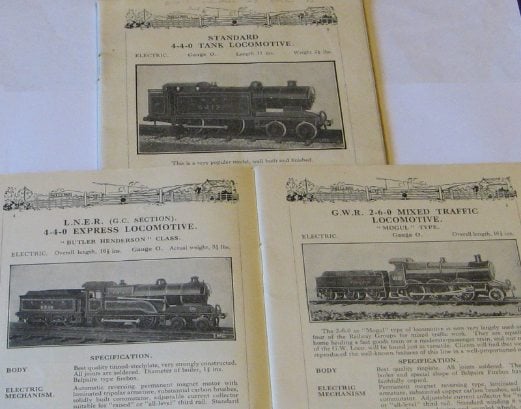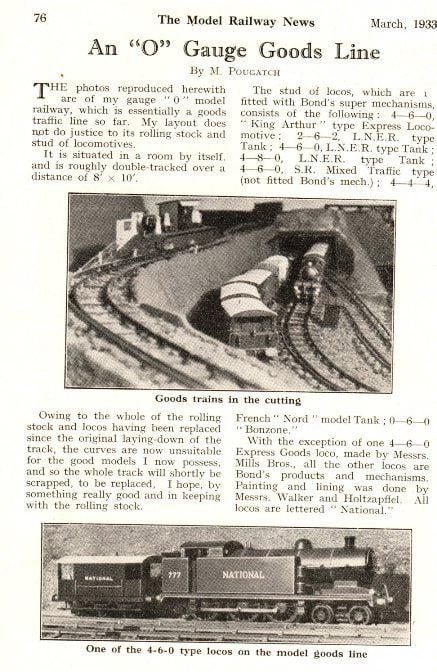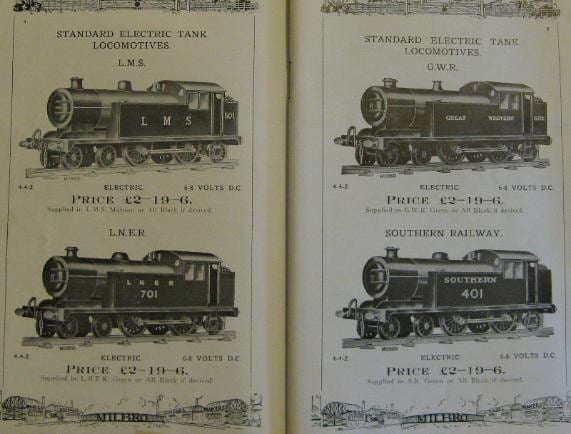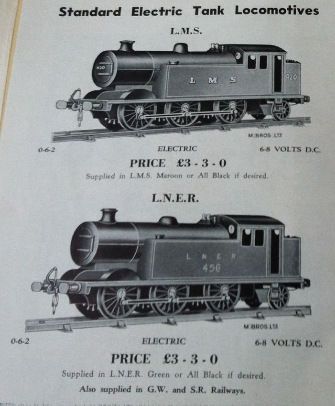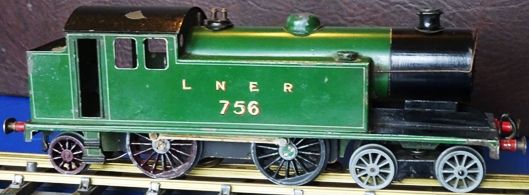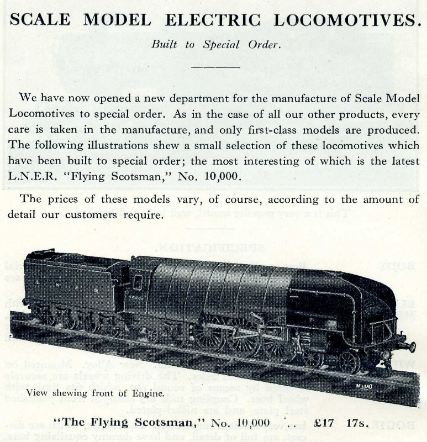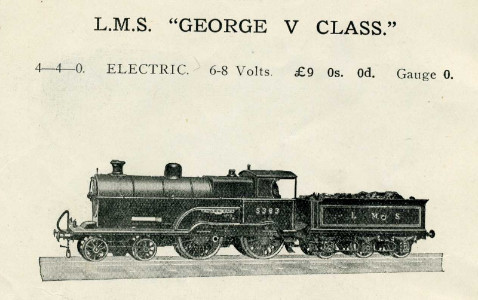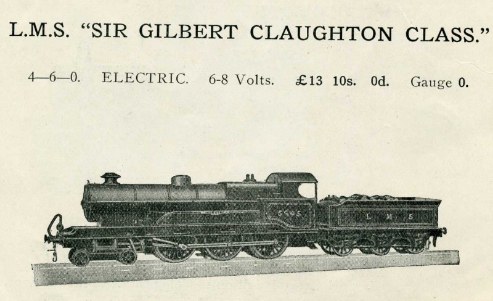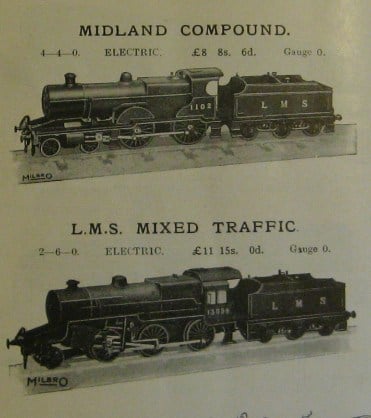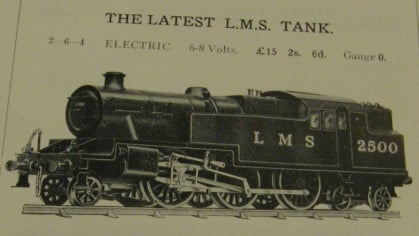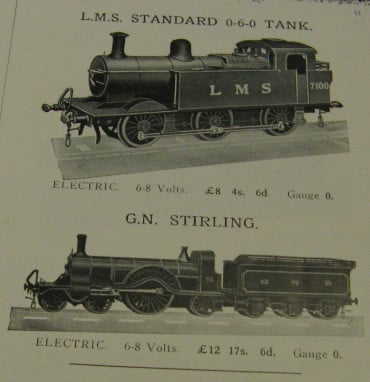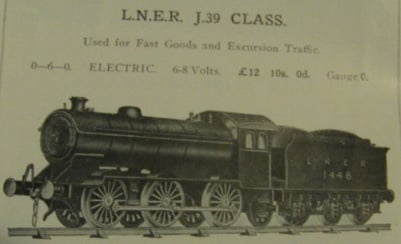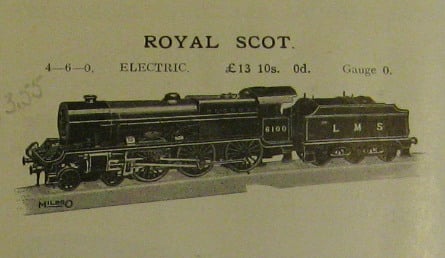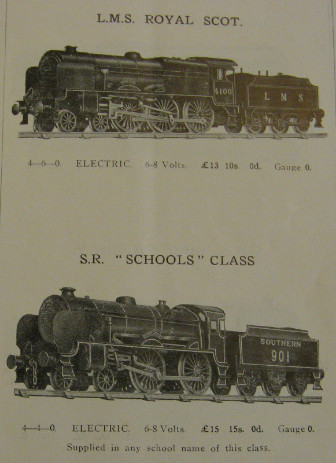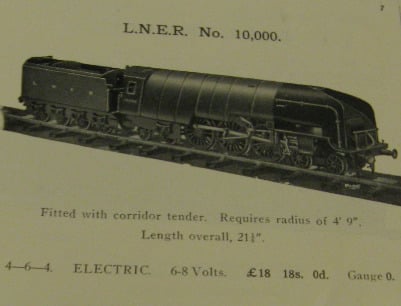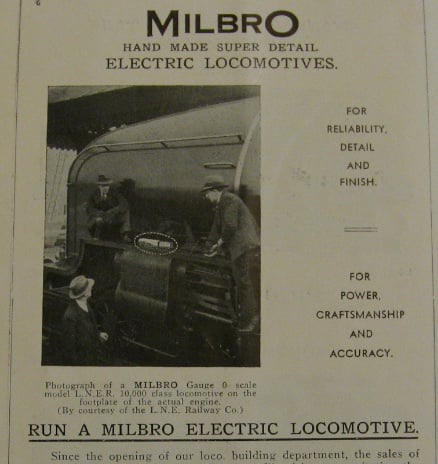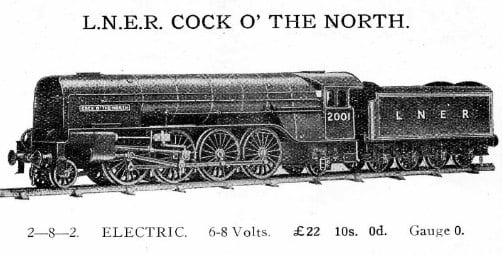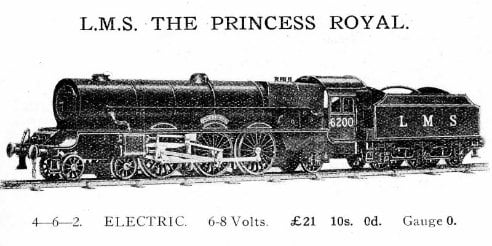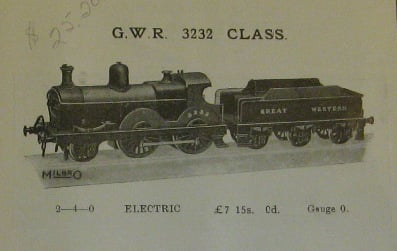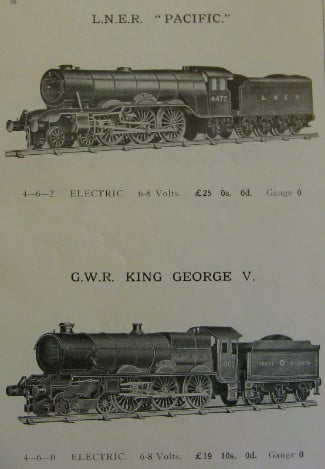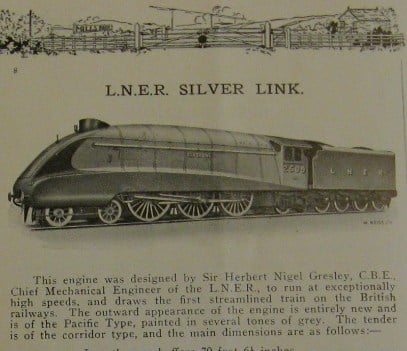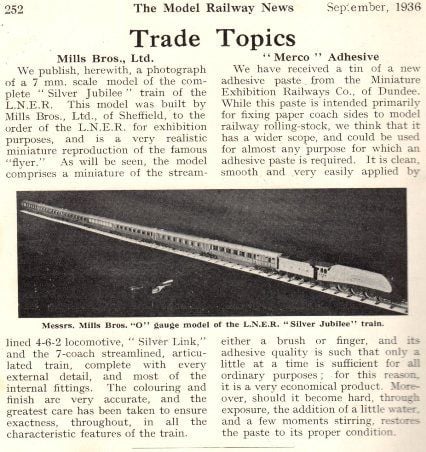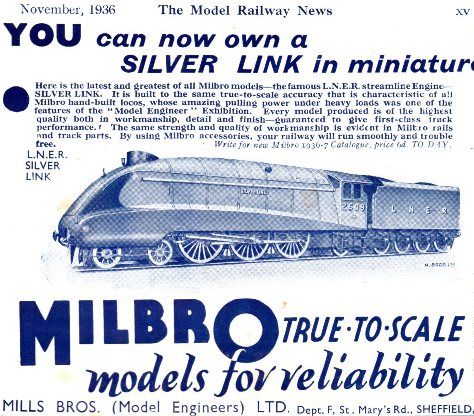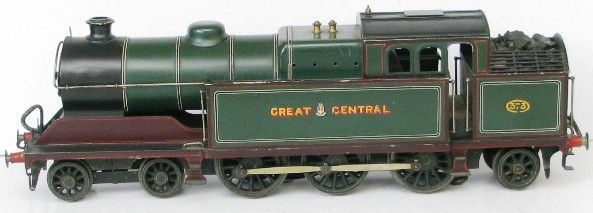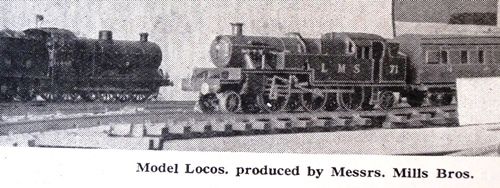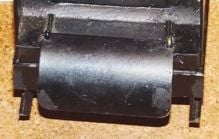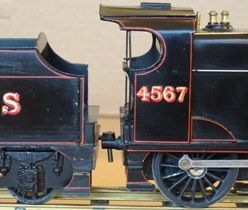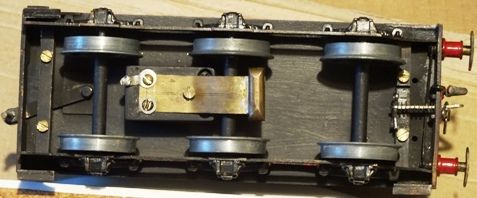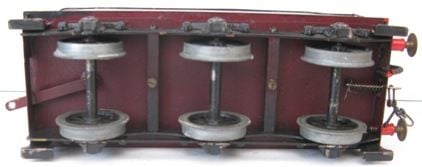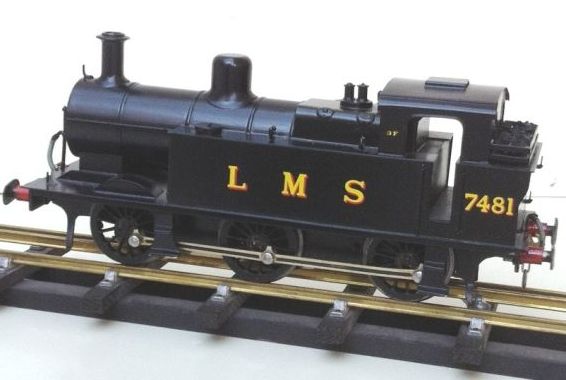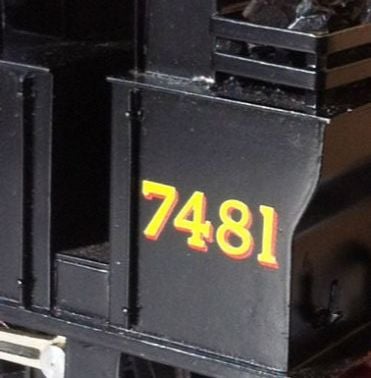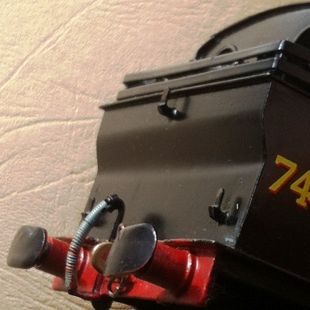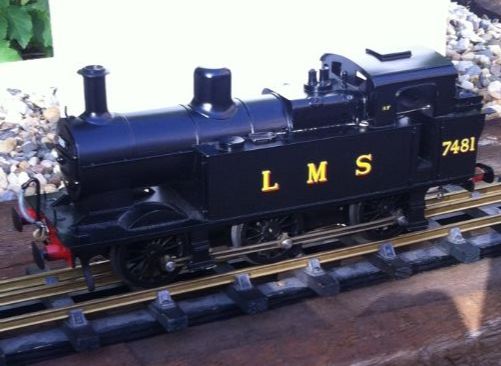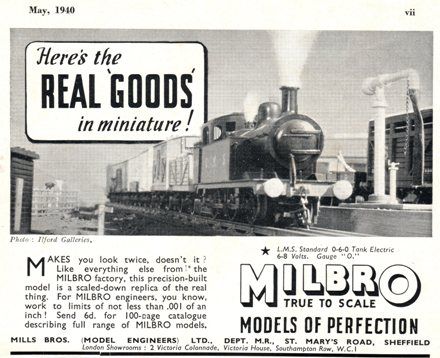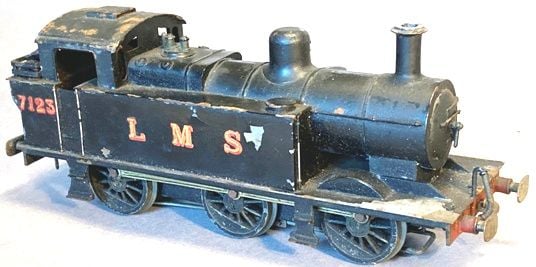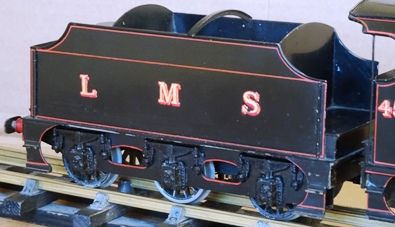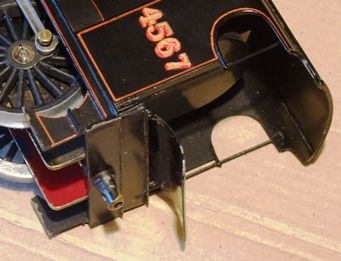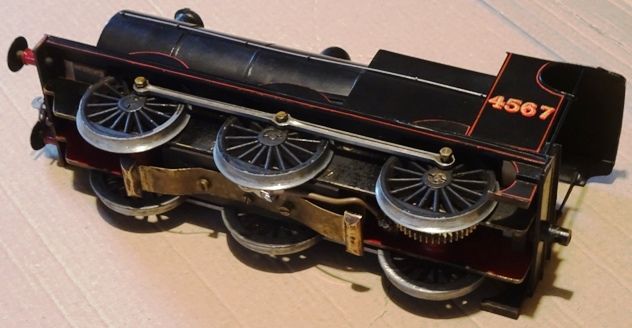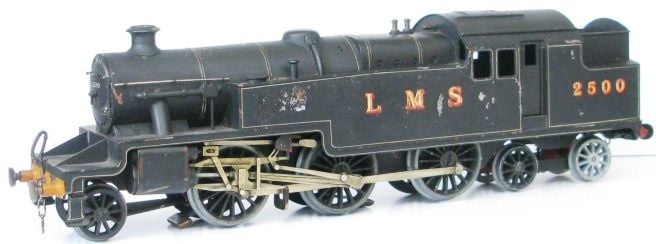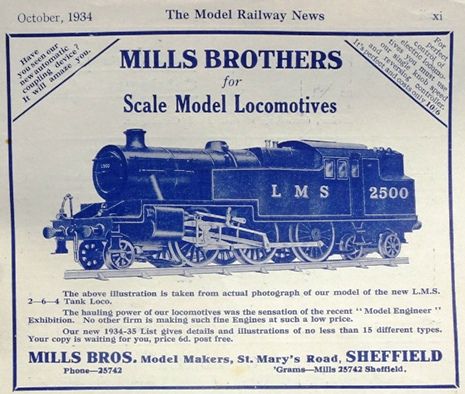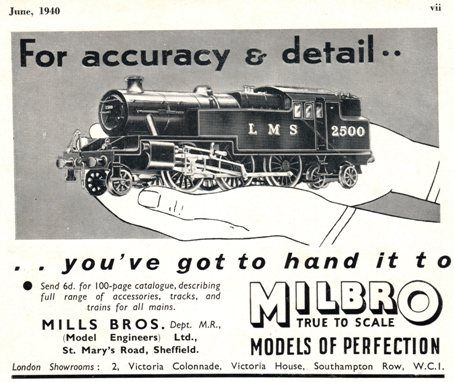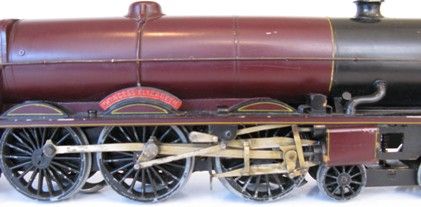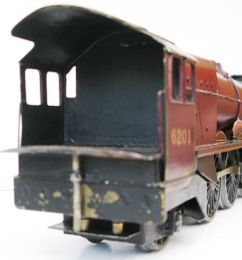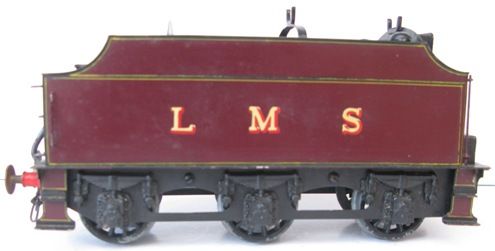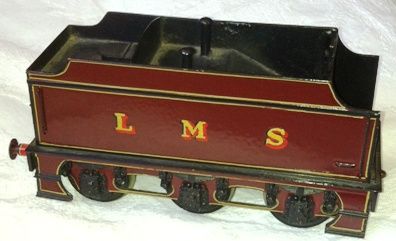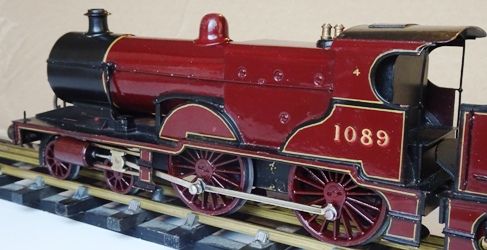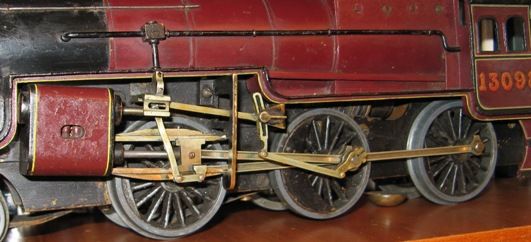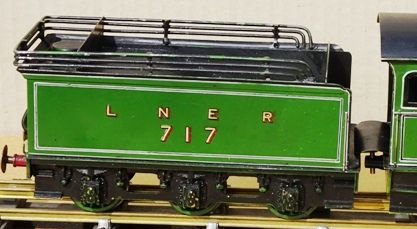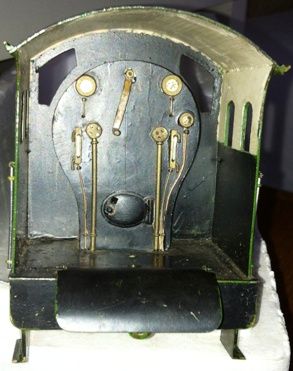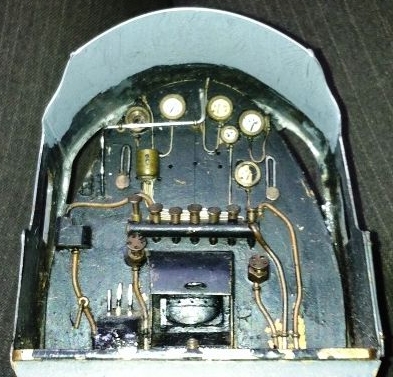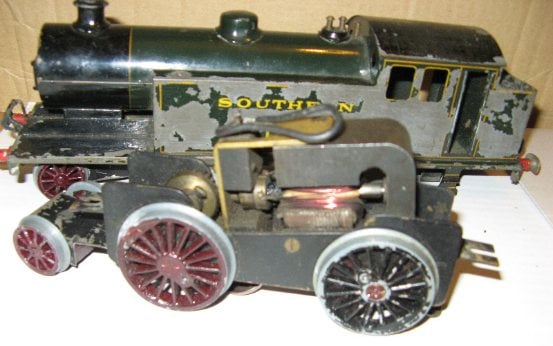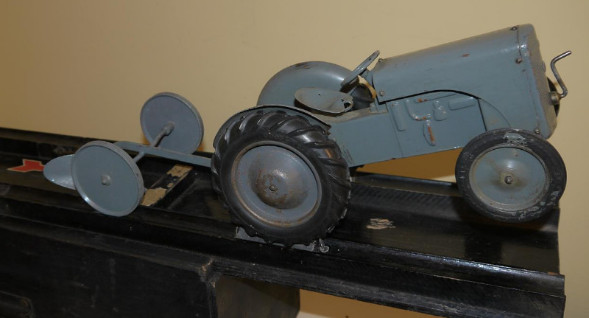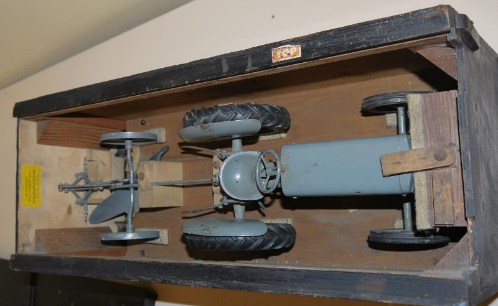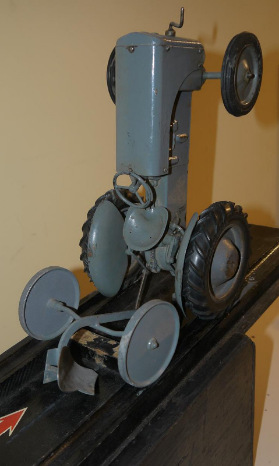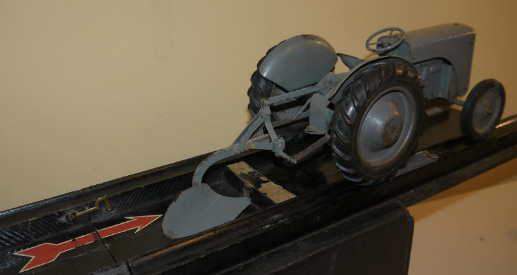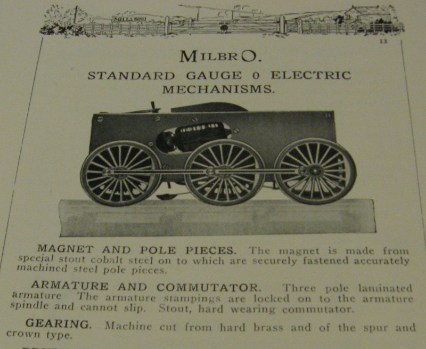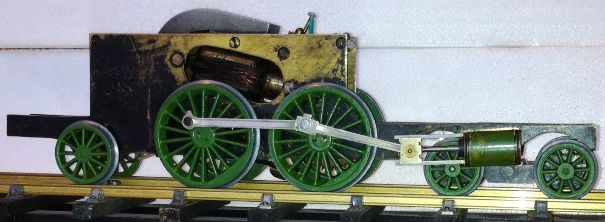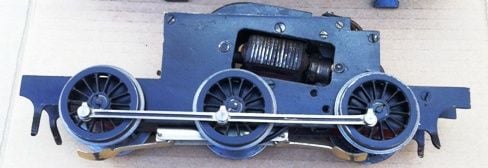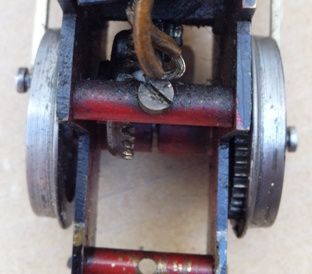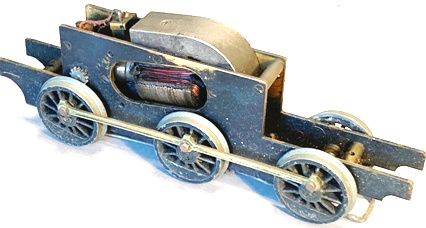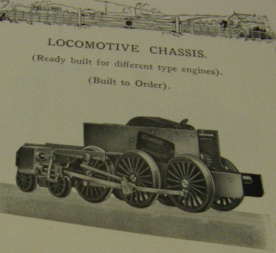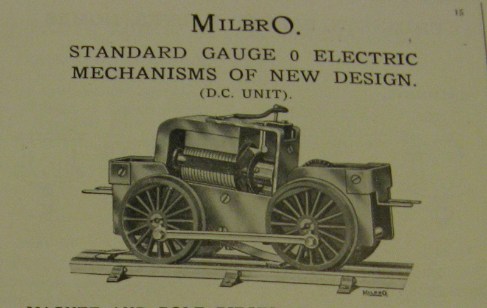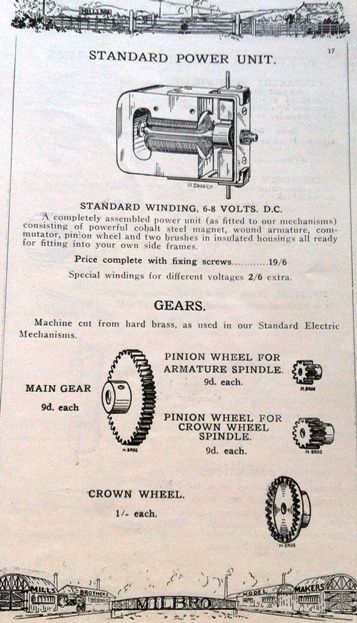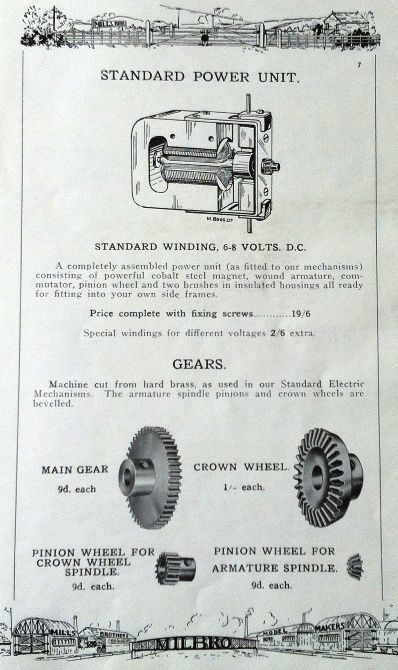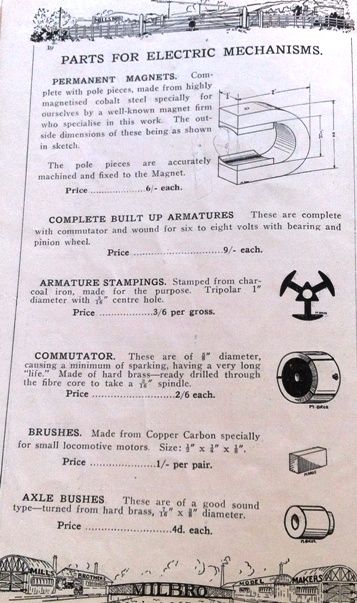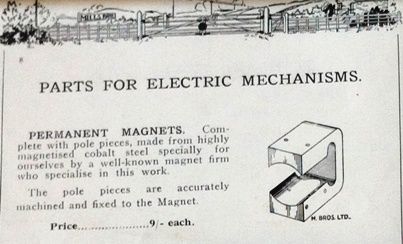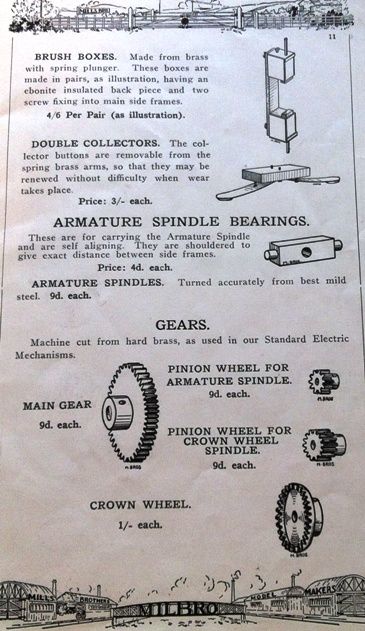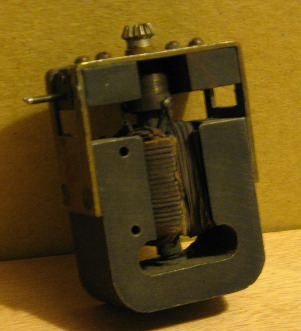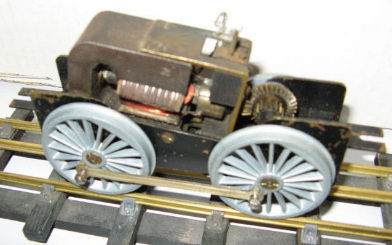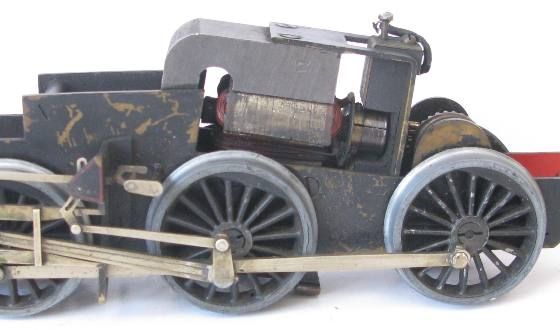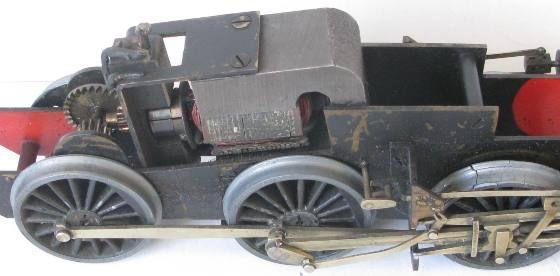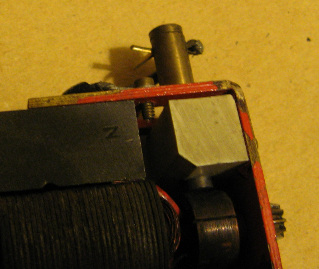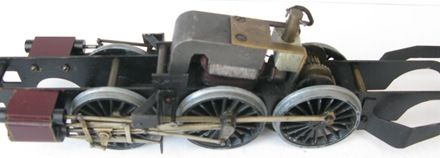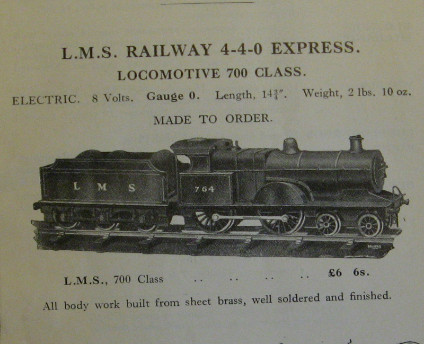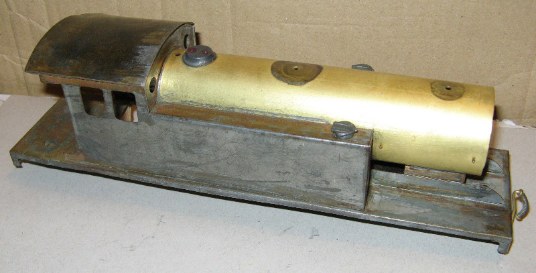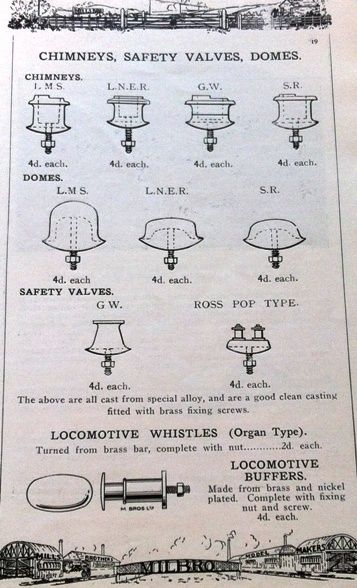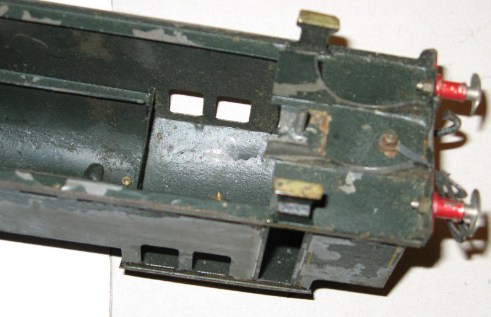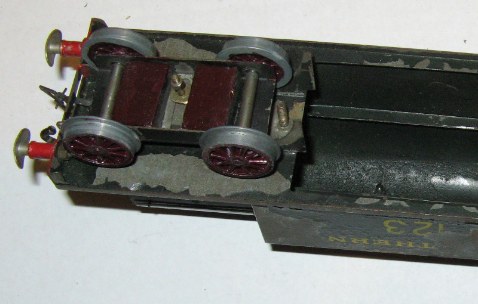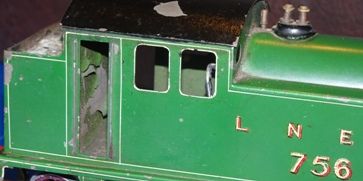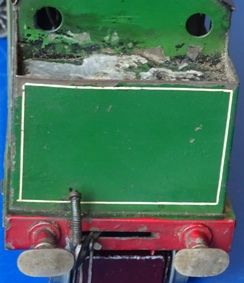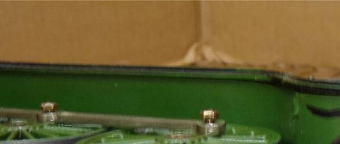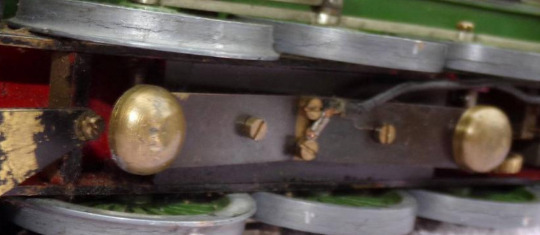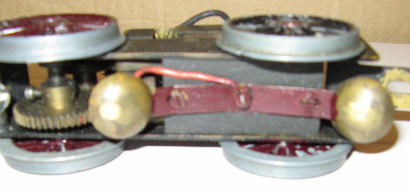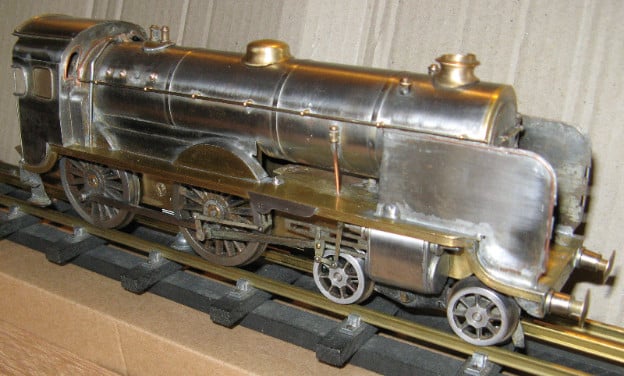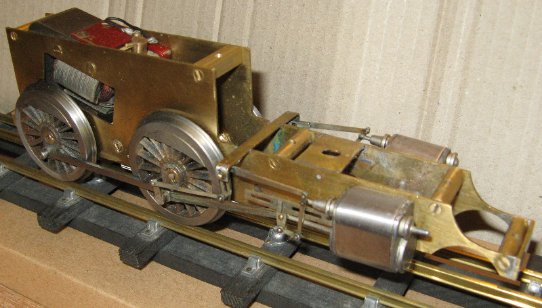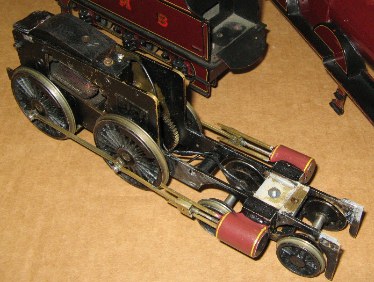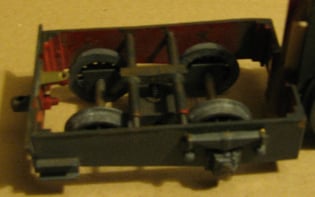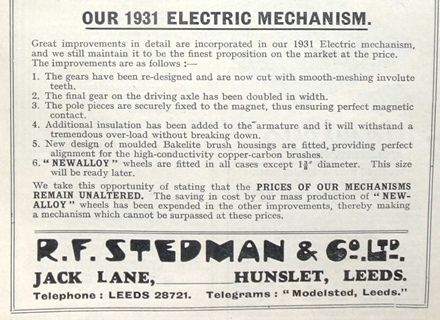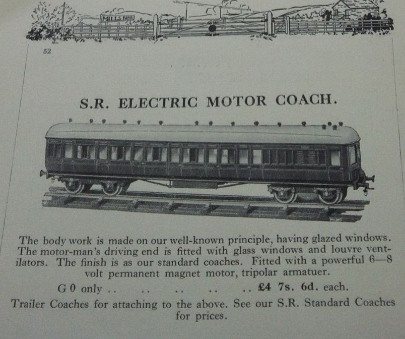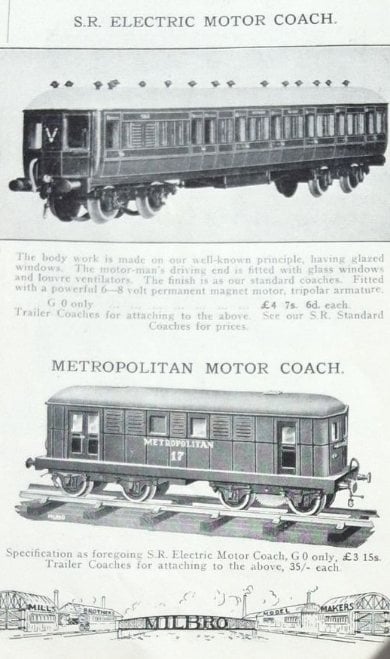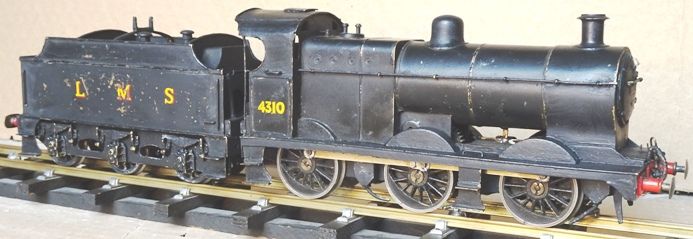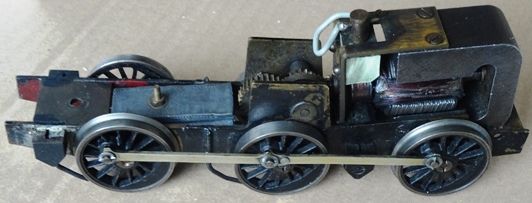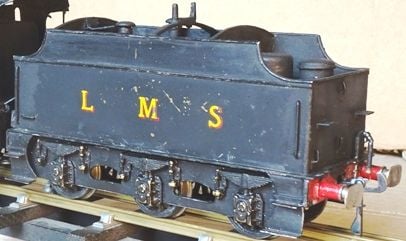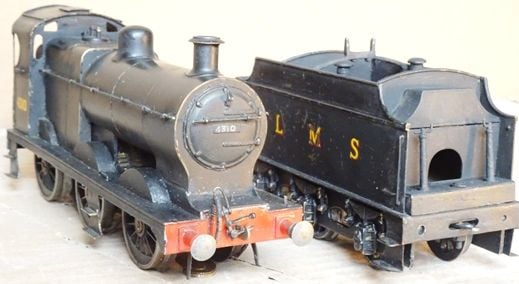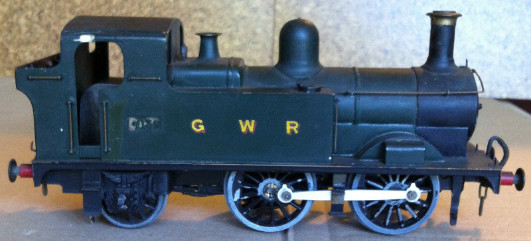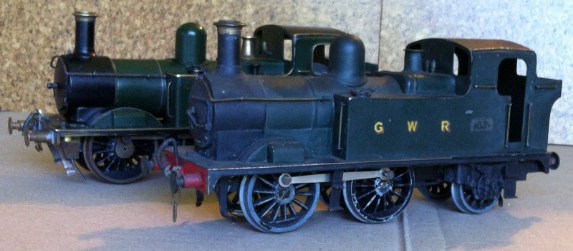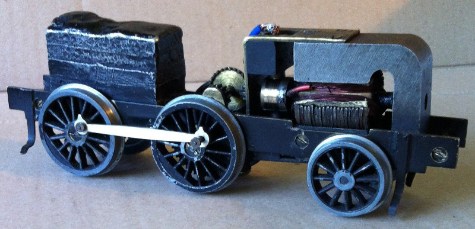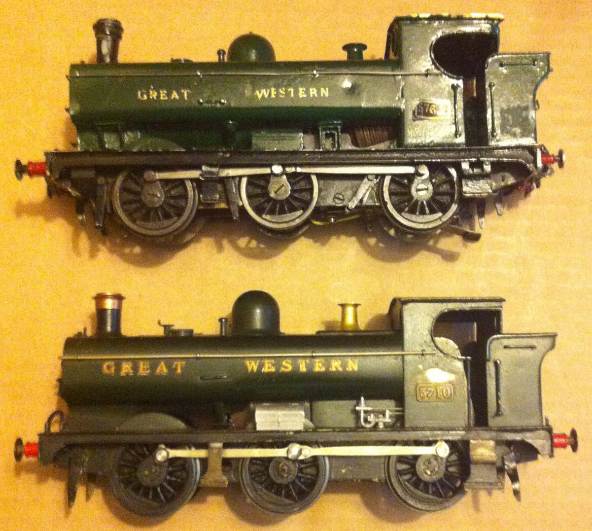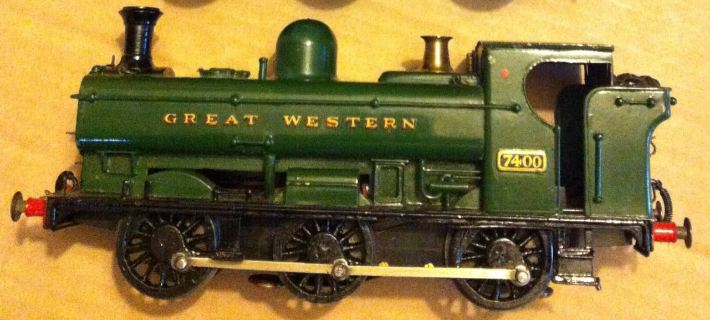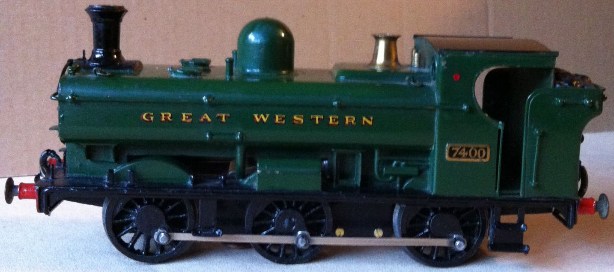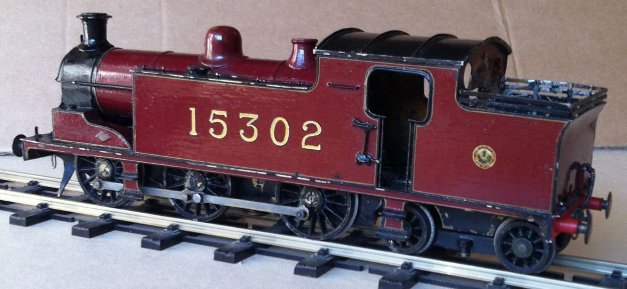
Milbro Locomotives* This section was most recently updated in January 2024 * AN OUTLINE AND DISCUSSION OF MILBRO LOCOMOTIVES
Copyright is retained by M.L.Harrison for all text and photos, except for those taken by other owners and enthusiasts. M.L.Harrison 2020 © All rights reserved.
This Locomotives part of the website contains information designed to give a reasonable impression of what Mills engines and their mechanisms are like. I have also been developing (with help from other collectors) coverage of some of the engines and motors made by other firms, and this appears in other parts of the site. Those sections are meant to help fill gaps in what can be found currently about the products of particular makers and firms, especially where they were competitors or collaborators with Mills in the 1930s, or played significant parts in 0 gauge production in the early post-war years. The coverage should also help put Milbro items in comparative perspective, say a little about 'Beeson for Mills' engines, and offer some outline information to assist in the recognition of motors. The commentary in the present section mainly concerns 0 gauge locomotives. I do not have any substantial knowledge about what the company did in larger scales as far as model locos was concerned, and the engines shown in Milbro catalogue illustrations were labelled by the firm as Gauge 0 items. This section of the website only comments very briefly on locos commissioned by Milbro from other makers (such as Beeson), or produced by Mills for other retailers. Beeson's work as a contractor for Mills is dealt with further in the separate section of this website introducing Beeson's 3-rail locos. In the post-war years there were links between Exley and Mills, and model railway magazine comments about Exley commissions during that era provide one of the few direct sources confirming ongoing post-war Mills activities with locos. Along with the locos discussed in this section, there is also an account of a model tractor which has historical significance, and sheds light on the kinds of projects that the Sheffield company could be involved with in the 1940s. I understand that Mills made a demonstration tractor model and two toy tractor models based on Ferguson tractors. Connections the firm had with the development of model aero engines are also touched upon below.
The Mills locomotives range Early Milbro catalogues featured specific locomotives from the Leeds Model Company range, and Milbro's images seem to be borrowed very directly from Leeds, as can be seen in these three pictures.
Illustration L1a. Three locomotives from the Leeds Model Company range, as catalogued by Milbro.
Illustration L1b. This intriguing report about a layout mentions a Mills loco, but doesn't identify it precisely. One possibility is that Mills had (under its own name) sold the enthusiast a Leeds 4-6-0 tank, since the above engine looks very similar to items from that range. On the other hand, this tank engine conceivably could be a Bond's model, and the Mills reference might be to the SR mixed traffic loco. If that is right (and I'm not sure it is), then Mills production of uncatalogued special order items in its scale model range must have begun before 1933, and probably even before the catalogues started to promote the range (see below). This article is also of great interest when considering the Bond's scale model range, since it seems that firm was already making models of this kind before its range was catalogued (see The Model Railway News, 9, 99, pages 76-77).
It was not until around 1931 that Mills began to publicise locos of their own manufacture. They offered to quote for engines to meet customers' needs, and displayed illustrations in their catalogue of models of particular locos. Catalogue pictures for this range are shown further down in this section. The price to be paid reflected the level of details illustrated, and it would cost a customer more to go beyond the kind of detailing shown in the catalogues. In 1935/36 the firm also began to market their own 'standard' tank locomotives. These (like those made by Bassett-Lowke) did not reflect specific protypes from full-sized railways. There was a 4-4-2 tank version and (added later) an 0-6-2. We have a picture below of an LNER example from the range. More photographs of standard tank details and a mechanism are included later below. (See also the Binns Road site for these tanks.)
Illustrations L2a and L2b. The four Milbro standard tanks introduced in 1935/36, and the 0-6-2 version shown in two of its four available liveries.
Illustration L2c. An example of a tank loco from the standard range. Some of the original wheels on this model have had to be replaced by ones from other Mills mechanisms or my spares box, and could do with green paint. The coupling rods are fluted on the outer sides only. The chimney and dome are of soft metal. For more details about these tank engines, see below (including Illustrations L21, L30a, L31, and L32a-L32c).
The more expensive items modelled on selected examples from British railway companies continued to be illustrated in catalogues, and what was shown shifted a little over the period of production before the war. Taken collectively, the catalogues show: a GNR Stirling 'Single'; a Southern Schools; a GWR 3232 Class 2-4-0 tender loco and a King; an LMS 0-6-0 tank, 700 Class, Compound, King George V class, 2-6-4 tank, 2-6-0 Crab, Claughton, Royal Scot, and Princess Royal; and an LNER J39, Flying Scotsman, A4, Cock O' the North, and No. 10,000 (the so-called 'Hush-Hush'). As the company made items to order, the catalogue illustrations certainly do not cover everything that was built, but the pictures are likely to represent models for which batches or single examples had been or were being produced (and perhaps for which parts were laid aside for further orders as needed). Photographs or scans of the catalogue pictures are included now, and the 700 Class one is shown further down the page.
Illustration L3. The 'Hush-Hush', initially identified in the catalogue as 'The Flying Scotsman'. I am informed that this name as used here would have been in line with LNER advertising at the time, through which the loco was linked closely with the Flying Scotsman train. Thanks to William Brown for historical information on this, and for showing me LNER images for the public that featured 10,000 within Flying Scotsman titling. The Milbro catalogue caption nonetheless might have looked confusing to some of the enthusiasts who were familiar with the pacific.
Illustration L4.
Illustration L5.
Illustration L6. The compound and 'Crab'. Note that the compound as shown here is not all that accurate as a representation of the protype, although the model is excellent as far as construction or engineering are concerned. See also below, Illustrations L19a-L19c.
Illustration L7. The cab windows seem to be of perspex or something similar.
Illustration L8. The catalogue picture of the LMS 'Jinty' shows a fairly simplified model (see comments for L18 below).
Illustration L9 J39.
Illustration L10 (early version of loco).
Illustration L11 Later version of Royal Scot, along with Schools.
Illustration L12a As was indicated above in L3, this loco was featured heavily in the first catalogue that presented the locomotives range. It was also shown in a journal advertisement in the same period (see Introduction section of this website). In some later catalogues a distinctive promotional page also made use of it (see L12b).
Illustration L12b Part of a promotional page that featured the 'Hush-Hush' loco.
Illustration L13. The Princess and the Cock O' the North. Two very substantial items.
Illustration L14. There were some annotations in pencil on this catalogue. Perhaps it had been to North America, as the marks at top left suggest the engine's cost there. See also the early version of the Royal Scot above.
Illustration L15. LNER Pacific and GWR King.
Illustration L16a. This loco was given a full page when catalogued.
Illustration L16b. Report of a display by Mills Brothers that included an 0 gauge A4, perhaps a super-detailed version of the catalogued model. See The Model Railway News, September 1936, 12, 141, page 252.
Illustration L16c. Advertising for the Mills A4 in The Model Railway News, November 1936, 12, 143, page xv.
Non-catalogued model locos Hammond's Guide (Ramsay's British Model Trains, 5th Edition, 2006, 287-288) adds further items for which I have not seen any catalogue pictures, and I assume these were made for specific orders or purposes; an LNER/GC 4-6-2 tank and LNER J72, and an LMS Coronation. A photograph of the GCR tank is shown at page 287 of that Guide, and a full half-page black-and-white picture of it appeared earlier (in 2000, page 90). The loco belonged to an enthusiast with considerable expertise, and has been attributed to Mills for more than two decades as a good example of a special order item from their range. It became a rather celebrated model when it was sold through an auction by SAS during the period of the pandemic, and achieved a very high auction price. I have not handled the loco, but it certainly has external features very appropriate for Mills, and has been identified over the years by people with good knowledge of vintage trains. (Were it not by Mills, then other options for it perhaps might be a commissioned engine from the even rarer Bond's pre-war scale models range, or perhaps an early Beeson loco.)
Illustration L16e. A model that has been attributed to Mills for many years, and is a highly attractive example of a special order item. Many thanks to the enthusiast who sent me this picture. For more comment see our text above. Recent reporting (at time of writing) from a small-scale model railway gathering suggests this model is a first-rate performer on the track. It may be of interest to compare it with the model of a similar loco shown in our Exley section, although the LNER livery on that engine looks rather dull in comparison with the GCR!
There were also an electric Metropolitan loco and Southern EMU motor coach that were briefly catalogued by Mills, and these were of wooden construction, being built along similar lines to Milbro coaches (see our later short sub-section below on wooden locos for the catalogue pictures). "Trailer coaches" were also supplied, although conceivably these might simply have been standard coaches. As far as non-catalogued locos are concerned, I have been able to locate an auction photograph of a Coronation via an internet search (alongside two other catalogued Mills locos auctioned by Christie's in 2004). There is also a Southern Lord Nelson model identified as being by Milbro at Brighton Toy and Model Museum, and this too can be seen via the internet. Enthusiasts can also find a further relevant loco that was subsequently added to the same museum's website; a very handsome LMS Beyer-Garratt attributed to Milbro, although apparently fitted with Bond's motors. In addition, I can confirm that there is an authentic LNER Raven Atlantic (see pictures on Home section and below), and I think there is (apart from the Schools), an SR atlantic and another Southern 4-4-0, although I have only seen that loco briefly and would need a second look to be sure of origin. Over the years since I became interested in Milbro I have heard or seen references made to further examples of non-catalogued locos. These were an LNER V2, N2 and additional 4-6-2 tank, an LMS Jubilee, 4F 0-6-0, and 2P 4-4-0, and GWR 4-4-0 and 0-4-2 tank locos. In May 2015, what I take to be an example of the Milbro 0-4-2 tank was auctioned on Ebay, and this is described and shown below (in Illustrations L42a-L42c). An LMS 4F 0-6-0 tender loco was auctioned in 2020 by SAS as a possible Mills item, and this too is illustrated later, although it is really best described as a 'part-Mills' model. Another (much plainer) 4F which is very definitely by Milbro came through an auction with other Mills items in 2021, and is featured in three places below. It offers very useful examples of features to look for when appraising a possible Mills item. In addition, later in this section I show some pictures of GWR pannier tanks, two of which appear to have had Milbro origins or strong connections (see Illustrations L43-L47). There is also a picture of a Highland banking loco which may possibly have been made by Mills (although that may be incorrect). In our Beeson section we include a condensing pannier tank sold via Gresham Models which seems to have had Beeson as well as Milbro connections. A systematic search of pre-war journals for reports might reveal more items, but would take some time. One example of a press comment is in The Model Railway News of September 1935. This refers to an LMS 2-6-2 tank made for the Manchester retailer Tyldesley and Holbrook (11, 129, p. 252). The model was fitted with a Bing clockwork mechanism, and was illustrated along with an LMS 0-6-0 tender loco that was similarly powered (see magazine photo below). This seems to have been a 4F, and conceivably might have been built overscale to accommodate the mechanism.
Illustration L16g. Two locos shown in a 1935 report about Tyldesley and Holbrook discussed immediately above.
Another press report in the same magazine in December 1937 noted that Mills Bros. had shown at an exhibition a model of the LMS Coronation Scot, and a large number of locomotives, including a G.C.R. "R.O.D" 2-8-0 (13, 156, page 314). An LNER 2-8-0 of this kind by Mills was referred to in a March 1940 article in The Model Railway News, and was described there as being complete with cab fittings (see Binstead, M.H., 'A Cosmopolitan Layout', 16, 183, pages 60-65). In 1939 a report noted that Mills had exhibited an "arresting model" of a Gauge 0 LMS non-streamlined Duchess 4-6-2 loco, which "in all its external details" was apparently "about as near to perfection as it could be, as well as being an excellent performer" (The Model Railway News, June, 15, 174, page 164). A summary of problems and points about identifying a Milbro loco It is sensible to be cautious about claims that a particular engine is a non-catalogued Mills product, and I have sometimes been over-optimistic about locos that I have come across or been shown. Nonetheless, there are probably quite a few authentic 'special order' locos in the hands of collectors, and it would be useful to consider possible guidelines to help in the process of appraisal of these and of potential examples of the catalogued ones. One criterion that is often recommended by collectors and dealers is the presence of 'drop-out' (detachable) frames that run more-or-less the full length of the loco body, with a Mills mechanism incorporated, and with (in the words of the company) 'all valve gearing fastened on to the main frames'. Even on this, however, there can be variations. The non-prototype standard tanks are not built in that way (see below, Illustrations L31 and L32), and the same might be the case on other items if there was a particular reason. If a loco was fitted with a clockwork mechanism (albeit rare with Mills), there would have been three differing main options for construction: incorporating the clockwork components into customised full-length frames; bolting front and/or rear frames sections onto a self-contained mechanism supplied by another company; or soldering front and rear frames sections onto the body so that a freestanding clockwork mechanism would fit between (as with the electric standard tanks). This introduces a complication for identification, especially if a freestanding clockwork mechanism has been replaced at a later time by an electric one. An additional issue is that the company was able to supply frames incorporating the electric mechanism and other Milbro components for people who wished to build their own models. Thus some scratch-built models from outside the factory conceivably might look rather like ones made directly by the company. Another complicating factor when trying to determine the maker of a model is the potential there was for sub-contracting in either direction; with Mills buying in the work of other makers or providing building services to other firms. Despite all the potential complications, some key factors for an appraisal are available. Finding a Mills electric mechanism that has been professionally tailored specifically to fit into a particular model is a very good starting point. If such a mechanism sits within full-length frames that can readily be 'dropped out', if the wheels are of the Leeds type but with Milbro (or Beeson) crankpins, if handrails are positioned close in to the body, and if the body is of tinplate and the dome and chimney of brass, there is a chance the model is by or for Milbro (assuming it is of good quality). However, some Mills locos were made using soft metal chimneys and domes, so soft metal rather than brass does not automatically mean an item is not by Mills. Soft metal could be used for convenience, appearance or economy.
Illustration L16i. Full-length frames, with the Leeds type of wheels generally used by Milbro. As seen here, Milbro used their own design of crankpins and these have a different thread from the LMC ones. Pickups vary, but this is one type used (although perhaps not the most common one). The coupling rod seen here is fluted on one side only. This loco is LMS 4F No, 4567, referred to again below. It is possible some Mills mechanisms were assembled by Beeson for Mills, and this might particularly be the case when Beeson was supplying a complete loco to be sold through the firm. It also seems highly likely that Beeson supplied loco parts to Milbro. I also think that there may have been a link with Gresham Models, whereby Milbro contributed mechanism parts, etc. (See the Beeson section of this site.) A couple of points can be added about additional Milbro identifiers at the level of specific detail. We refer below to distinctive lamp brackets that may be seen occasionally on Mills engines (see Illustrations L17a-L17d). Some models (perhaps more probably the cheaper ones) also have steps that are brass castings. Some locos have very large buffers. A particular curved design for fall-plates has been adopted on some tender engines (see illustration immediately below). On some models a distinctive fitting was bolted onto the engine to pull the tender (see second and third pictures immediately below). When coupling rods are fluted this may well be on one side of the rod only. Finally, the frames below tenders normally will be removable so that wheels can be changed. There can be various ways of fixing these frames, including having L-shaped supports or brackets attached to them, but I suspect the more usual form was to build a rectangular framework that was bolted to the flat base of the tender* (see the fourth and fifth pictures immediately below). Additionally, axle-boxes/axle-box covers may be of brass, and perhaps usually are Bond's ones. I should add, however, that these observations are based on rather small samples, and therefore should be viewed cautiously as possibilities rather than certainties ! (*NB This approach for tenders may also be found on some pre-war Exley models, and seems to have been used on at least one early Beeson loco too.) (This fall-plate is held by split pins that are fixed to the cab floor. I think this curved shape or something similar may have been the preferred Milbro factory form.)
(With the fall-plate now lifted out of the way, the fitting to connect with the tender can be seen. Some Mills locos have this type of fitting.)
(The connection viewed from the side.)
(When the four visible bolts near the tender ends are taken out, the frames lift off as a complete 4-part unit.) Illustrations L16j-L16m. These photos show some of the details from Milbro LMS 4F No. 4567. A previous owner has moved the rear retaining cross-piece away from the buffer beam so as to introduce sprung buffers. Some more photographs of the engine can be seen later below.
Illustration L16n. Another example of a Mills tender. In this case the 'cross-pieces' are located further from the tender ends, perhaps because this is a longer tender. Thanks to the owner of this model (a Milbro Princess) for letting me have this picture. For other photos of the loco and its tender, see below.
By way of an introduction to what Milbro could offer, I now provide a few pictures of examples of locos and their detailing.
Some illustrations of specific Milbro model locos, with a few examples of loco details I have not so far seen a Milbro LMS 'Jinty' 0-6-0 tank loco that looks like the picture shown in Mills catalogues. The catalogued version seems to differ from the full-sized prototype in having cab sides directly aligned with its tank sides. The firm certainly may have made 'Jinty' models early on that matched its catalogue images in that way, but more realistic models of this class were also made by Mills, and perhaps these superseded the catalogued version quite early on. The photograph immediately below shows a Milbro 0-6-0 tank that relates very well to the full-sized LMS engines of this class (even though it is a little simplified). It most likely dates from the middle or first half of the 1930s, although it might be a little earlier. The two pictures that immediately follow this are to highlight specific details. At the end of the 1930s the Milbro LMS 0-6-0 tank cost £9 10s.
Illustrations L17a-L17d Milbro LMS 0-6-0 tank engine from the 1930s. This well-made tinplate model is powered by what might be described as a Mills 'side-geared' mechanism (see below, Illustrations L23c and L23d). The loco captures well the character of the full-sized engines of this class, although the vertical handrails on either side of the cab doors seem to be positioned in an unusual way. That may be a specific characteristic of the design Mills adopted in the 1930s for this type of tank engine, as I have seen it also on another model of this type. That engine (in pre-grouping livery) also shares other characteristics with the one shown here. Both have steps that are brass castings, and which usefully may be compared with those deployed on Milbro standard (non-prototypical) tank engines sold in the 1930s. The tall dome with a rather flat top is similar on the two models, as are the distinctive lamp brackets at the rear of the bunkers. I am informed that the latter have been created by folding metal. Unfortunately the Midland loco has had its mechanism changed, and I would need to examine it more closely to see if it too might initially have had 'side-gearing'. The loco illustrated above has what I take to be a factory number marked on its mechanism and scribed on the underside of the body. The model had lost its fire irons, but for the fourth (outdoors) photo I have placed a vintage shovel on top of the side tank. I understand that this loco was part of a collection that included several high-quality vintage LMS engines by well-known makers. A number of these models - including this one - were refurbished to very high standards by the expert restorer Simon Greenwood, prior to their sale. I understand that the jinty subsequently suffered minor damage to its rear buffer beam (which has been put right and reinforced). Illustration L17d1. Advertising at the end of pre-war production. See The Model Railway News, May 1940, 16, 185, page vii.
The above advertising appeared at the time of the firm's last large catalogue, and suggested a model of the Jinty was being offered that reproduced its full-sized prototype very realistically. A similar advertisement appeared in the Meccano Magazine (xxv, 6, June 1940). It does not look, however, as if the model in the picture quite matched the claim in the text below it, and it may well have been much the same as the example we showed above. Perhaps, however, there may have been times when a model was actually commissioned by Mills from J.S.Beeson rather than built 'in-house'. The loco shown in our next three illustrations is believed to be by J.S.Beeson for Mills. It deploys similar Milbro steps and folded lamp brackets (at the rear), but has better cab handrail arrangements, very good coupling rods, and different fittings above the boiler. It also has a couple of Beeson-style marking out lines under its paint, locating the cut-out apertures on the tank sides that I am informed represent hand holes for sand boxes (although these have been filled with lead). My assumption is that these were filled in primarily because the Milbro specification for the model did not cater for them or for the fittings that could have been seen within them! There are only fairly minor dimensional differences between the two Jinty tanks shown here, and each is just a little longer than scale length. The cab roofs are constructed similarly.
Illustrations L17e-L17g. LMS 0-6-0 tank locomotive, believed to be by Beeson for Mills. This engine is very well made and is substantially (and neatly) weighted with lead. It has split pins through the crank pins to secure the coupling rods. Of some interest is the fact that the fire irons remain in place (as catalogued by Mills) above the side tank facing the viewer. The loco has suffered from loss of paint in places. It has had some minor restoration, but needs further tidying up. The chassis has lost some fittings (possibly brake gear, etc.) and has also been altered to suit a changed motor. The loco's steps are of similar manufacture to those on the Mills jinty (although one has been replaced), and the lamp brackets at the rear are also much the same. There are signs that the original mechanism was of the 'side-geared' type found in the loco shown in Illustration L17a. The guard irons have been fashioned as continuations of the metal of the brass frames rather than being additions that are soldered or bolted on. This has also been done for the Milbro Jinty shown in Illustrations L17a-L17d. In the third picture I have tried to reveal one of the the cut-out shapes (mentioned above) that have been filled in with lead below the letter L on each side of the engine. The photo has not worked very well, and I will try to take a better one when time permits! 7283 is a good representation of an LMS Jinty, although very much in the style of the pre-war three-rail period. It has no rivet detail, and the valances below the body are not really modelled. Some further images of the loco are included in the Beeson section of this site.
Illustration L17h. I am grateful to the enthusiast who sent me pictures of this Milbro model, which turned up in 2021, after most of the above text had been written. It is similar to the Jinty shown in Illustrations L17a-L17d. It is of tinplate, and has one of the 'side-geared' mechanisms mentioned above. Perhaps that type of mechanism may have been the standard Milbro one for a Jinty, and most likely remained in use by the firm after the introduction of their later mechanisms in the mid-1930s. For the side-geared mechanisms, see Illustrations L23c-L23e below.
Illustrations L17i-L17l. A Milbro model of another standard and widely-known LMS loco type, the 4F. We showed a few pictures of its detailed features earlier above. Although the full-sized engine represented by this model was built in 1937, this tinplate loco has one of the earlier types of mechanism. I suspect that Mills 0-6-0s were still being fitted with these older units for economy reasons even after introduction of new Milbro motors in the mid-1930s. The 4F model is in good shape overall. However, several of the original driving wheels had swelled and deteriorated when it appeared in an auction in 2021. Although these have now been replaced, the set overall is still just a little oversized, as none of the smaller spare ones available would take the Milbro crankpins! The present set works well, but for the moment it has been necessary to insert a couple of very thin wafers of wood to raise the body slightly above the frames. This avoids the flanges on the centre wheels catching on the body.
Illustration L18a. LNER Cock O' the North locomotive. This specific model was auctioned on Ebay in 2014, and the above picture is reproduced here by permission of the photographer involved with that sale. The loco was one of a group of three different Milbro engines that had apparently been kept most recently in display cases, but there was nonetheless evidence of substantial use in the past. All three seemed to have LMC soft metal wheels, with some degree of fatigue. As catalogued by Mills, this engine was described as being for 6-8 volts, and cost £22 10s when introduced in 1934/35 (being then the most expensive model amongst the 'typical examples' shown). By the end of the decade the price was £25.
Illustration L18b. Milbro LMS 2-6-4 tank loco. This was a very convincing model, and one that the firm used in its journal advertising (see next pictures below). The example shown is likely to have been made in the mid or late 1930s. I am grateful to the owner of the engine for letting me show this photograph and the two additional pictures of its mechanism that are presented later in Illustrations L27b and L27c.
Illustration L18c. The company made use of the 2-6-4 tank in its magazine advertising, at a time when the full-sized prototype was a new engine. This is from The Model Railway News, October 1934, 10, 118, p. xi. The picture suggests the model shown was perhaps running with 'outside third' pickups.
Illustration L18c1. The model was still being promoted later on, at the time of the firm's last large catalogue. See The Model Railway News, June 1940, 16, 186, page vii.
L18d-L18h. Many thanks to the owner of this impressive and convincing model for letting me have the illustrations of it shown here and elsewhere on this website. Our catalogue excerpts above included the picture of a Princess as Illustration L13. I think the example we present here was made late in the decade, given its mechanism. A second photograph of this mechanism is included below, where we comment on features and developments in motors, etc. Perhaps the design for the engine-to-tender connection on this model may have been borrowed from seeing Beeson's regular practice, as it is similar. On the other hand, it is conceivable that Beeson contributed to the manufacture of this loco at some point (such as by supplying parts).
Illustrations L19a, L19b, and L19c. A Milbro LMS compound. This is the only 0 gauge compound I have ever seen where the front end matches the Milbro catalogue illustration (although the loco number is not the same as on the catalogue model). It may be that later versions of the Mills compound were more true-to-protype in this respect, but I have no information to be certain on that. An earlier owner gave this loco a very impressive new coat of paint several decades ago, but it was also converted to two-rail running and the cylinders were damaged and moved. The tender was also altered and damaged. The model has now been put back into a 3-rail form, and Brian Cain has restored the underneath of the tender. The 2-rail steel wheels have been replaced with LMC-type wheels in line with the original state of the model. This engine is from the first half of the 1930s (or earlier), and pictures of its mechanism are shown elsewhere on this website (see Illustration L38). It is also shown on our Home Page. The body components are almost all of tinplate, but the two framing sections above the base plate at the front end seem to be of brass. One guess would be that they were made by adapting brass ones from the stock of parts available from the '700 class' models (which were originally advertised as being made in brass). The smokebox door is of tinplate, and is very neat despite being a simplification. The steps are made in brass, as are the cylinders.
Illustration L19e. The catalogue extract shown above for the compound also included the 'Crab', and what I hope are some informative details of a Mills 'Crab' are shown now (cylinder, motion, pickups and cab window surrounds). I am grateful to the owner of this model for letting me show the picture here.
Illustrations L20a, L20ai, and L20b. Details from the NE atlantic shown on our Home page; it is neatly made but very plain. This is an early Mills loco, probably from the first half of the 1930s or before. Its mechanism is shown later in this section. The model is in very good condition for its age. I have done some minor restoration and re-wheeled the engine with better LMC-type wheels, as the original ones had deteriorated.
Illustration L20c This shows the cab detail in another Mills model loco from the same period as the Atlantic. It is an LNER 'Hush-Hush' 4-6-4, and its mechanism is pictured later in this section of the website. The engine has been undergoing repairs, and is currently awaiting some improvements to its paintwork (which had been amended and poorly overpainted in places by a previous owner). This is an interesting backhead which shows what Milbro could do (or commission) for an expensive loco. Some parts are missing from the upper central area, but the rest has survived quite well.
Illustration L21. An example of the new design of mechanism introduced in the mid-1930s, in front of the body of one of the 'new standard electric tank locomotives' introduced in the same period. The body behind is of the 4-4-2 tank to which the mechanism belongs. Milbro's 1935/36 catalogue explained that these new models were built to a standard design as regards the body work, but fitted with chimneys, domes, etc., 'to the particular railway group they represent'. It seems that these non-prototypical models performed very successfully on layouts, and the price was just under £3, very much less than what had to be paid for a more realistic Mills loco. The new motor design was neat and robust, with sensible housings for the plungers and brushes and a good gear train. Erosion of paintwork can be a problem on many models from this period, and is illustrated all too clearly in this case! This particular loco has also lost some fittings from the tops of its side-tanks, and has had some wheels replaced by maroon ones.
Activities of the company after 1940 Unfortunately, little published material is readily available about Milbro's post-war practices, or about items the company may have produced then. The 1940 catalogue had described Mills Bros. as model railway and commercial model builders on its first page, and also referred there to British made scale model locomotives, railway track, buildings, and rolling stock. After the war the locos disappeared from the lists, and catalogues were much thinner. Although the firm's London showrooms were initially still featured in two photographs, this did not last long either. Coverage was however soon being given to 00 gauge as well as 0, and Mills claimed to be producing as well as simply listing 'equipment for G 00 model railways' (see for instance 1951 catalogue, 27). In June 1959 one of their regular advertisements actually contained solely 00 gauge items (Model Railway News, 150). It would be useful to have a company history to draw upon, that would include accounts of relationships with other firms within and beyond model railways, indicate any effects from war damage or loss of staff, and review the availability and use of materials. Although anecdotes and narratives from older enthusiasts can be helpful in describing particular experiences or contacts, I have no printed information on how far Mills engaged in direct model production (as against retailing) after the war. Interestingly, written accounts from the world of model aeroplane engineering give some historical importance to Mills/Milbro 'compression-ignition engines', for which patents were apparently obtained in the mid/late 1940s. From what is available on the internet, it seems that Arnold Hardinge, the key designer for these excellent products, 'went into business' with the Sheffield firm in the immediate post-war years, and at some point 'bought their name and set up a small factory' in Surrey [1]. For a short time Mills Bros. seems to have been operated simultaneously from three different addresses; in Kent, Yorkshire and London. One source [1] has suggested that the new owner 'discontinued the production of model railway track', and concentrated on aero engines, as well as manufacturing high-precision components for companies such as Vickers, the Royal Aircraft Establishment or the MoD. A later authoritative and very well-researched paper by A. Duncan and D. Owen has provided a useful overview of Mills Bros. history, with comments on what happened after the war, and on the aero-engine enterprise in particular (see www.adriansmodelaeroengines.com; consulted December 2016; adrians model aeroengines). I am grateful for useful observations in correspondence from one of these authors. Although further research would be needed to verify events, it appears likely that the people producing model railway equipment from the Sheffield factory either retained some rights and facilities to continue to use the Milbro trade mark after sale of their company's name, or (perhaps more likely) bought back the rights and/or premises in some way. In any event, the changes at company level did not end the sale or production of model railway items under the Milbro name based at Sheffield. The company name of the model railway supplier did change, however, to become Mills Bros. (Sheffield) Limited. Meanwhile, Mills Bros. (Model Engineers) Ltd. was creating very different products from its new location in the south-east. Without a thorough check of the contemporary model railway magazines and of the Sheffield company's marketing, it is not possible to see what rearrangements (if any) might have been made by Mills Brothers of Sheffield in their advertising, to take account of the sale of rights to their brand. In August 1950 (p xvi) and September 1950 (p. xvi) the regular Milbro advertisement in the Model Railway News changed, and made no mention of the brand name Milbro. It referred simply to Mills Models. All the catalogues I have so far seen, however, have featured the Milbro trade mark, and this even seems to have applied when the company briefly adopted a catalogue cover that headlined the title Mills Models (1955). I have been sent information about a batch of most interesting non-railway items that were made with a Sheffield 'Mills Model' logo in the 1940s, and the person who has been in touch has also very kindly let me have some photographs showing one of these models. The Mills Model trade mark is featured in the Artwork section of this site. These models were tractors, and another picture of the one shown below is included in the Introduction section. My expert informant has explained that this model was 'really a tool', and served (together with its substantial wooden box) a very particular purpose. I am very grateful for the time and trouble he took to set matters out for me, and hope I have not misunderstood things on points of detail. The tractor was not made as a toy, but was intended to be used by tractor sales-personnel to demonstrate a safety feature developed for Ferguson tractors. Before this development, there was apparently a danger of accidents arising if a plough (conventionally hitched low-down to a tractor at the back) hit an obstruction such as a large rock or tree root. When that happened, the vehicle's rear wheels could act 'like a hinge flipping the front of the tractor up and over', and this could prove fatal to the driver. Ferguson's design was intended to counter this by what was referred to as 'the 3 point hitch', which apparently shifted weight and power so as to cause the rear wheels to 'dig in', with the tractor staying on all four wheels. The special black box in which the model came included sliding sections that could be used to form a 'run way', along which the operator could send the tractor; first with a pulled plough that precipitated a 'flip' when an obstruction was hit, and secondly with a plough attached via the '3 point hitch', which meant that the vehicle stayed put. The person who sent me the pictures also explained that the drive is a spring made to travel only about 16 inches, and that this has now lost its power. The tractor is clearly of historical significance, and a reminder of the usefulness models have often had for exploring, demonstrating or testing features of engineering or practical performance. One would expect it to be of interest not only to people enthusiastic about vintage tractors or agricultural vehicles, but also to a wider range of engineering historians and enthusiasts across related fields. Since setting out the above note, I have been made aware of a publication that adds substantially to the story of Mills Brothers model tractors (and I am grateful to Laura and Bill Truin for alerting and informing me on this). The book is 'Farming in Miniature: A Review of British-Made Toy Farm Vehicles up to 1980; Volume 2: Dinky to Wend-al.' (R. Newson, P. Wade-Martins and A. Little, 2014, Old Pond Publishing, Sheffield). The writers confirm that Mills Brothers were asked by Harry Ferguson to make demonstration models of the Ferguson TE20 tractor and its revolutionary three-point linkage system, and that demonstration 'kits' (consisting of a tractor and two ploughs) were made to be used by salesmen worldwide when the full-sized tractor went into production. They also explain that Mills Brothers additionally produced two toy models of the TE20, these possibly being to promote the tractor, although examples of these models are rare. One apparently had elastic band drive, while the other was friction-driven. One further piece of related information on Mills tractors came to light when I was researching Milbro products through a general internet search some time ago. It had been reported that a museum in Melbourne Australia had a Ferguson demonstration model tractor. This was apparently one of seven such tractors made by Mills that had been brought to Australia in the early 1950s. It seems that in 1953 the Ferguson tractor was promoted to rural Australia through the 'Ferguson Circus', which travelled from town to town, and involved lectures and demonstrations of the 'Ferguson System'. There was a booklet of instructions for the salesmen using the models. See the link below for the Museum: https://collections.museumsvictoria.com.au/items/724486
Illustrations L22a-L22d Mills tractor models like this one were supplied by Ferguson Tractors to the main dealers of their vehicles in the 1940s. I am very grateful to the person who supplied these pictures and outlined the history and purposes for me. See the text above for key points, and the Introduction and Artwork sections of this site for further pictures. Since being sent this information I have also been referred to a book that chronicles the events around the production of these demonstration models, and refers to some other tractors also produced by Mills Brothers (see text above).
As regards model railways, what can be said with certainty is that the scope of what was attempted after the war looks much narrower than it had been before. Post-war Milbro advertising in the model railway press often tended to refer to track parts, but I have not yet seen any examples of offers in such media to provide locomotive building services directly for enthusiasts (although systematic search might reveal more information). There are, however, at least four press reports in the 1950s demonstrating ongoing involvement with railway model construction. Two are about the same event. One of these is in the Model Railway News of May 1959, and refers to work carried out by Mills Bros to an order of Edward Exley Ltd for a Washington DC client. A train of four coaches was built from K's kits, and a picture is shown of these in that journal issue (page 110). The Railway Modeller had carried a similar report in November 1958, entitled "Special For America", noting that the set of coaches represented "one of the first 00 models produced" by Mills Brothers (9, 97, page 265). A third report about model-building involving Mills also appeared in the 1958 Railway Modeller, and is reproduced below. Again, it arose from a collaboration with Exley, and this time the commission was for a non-working model.
Illustration L22e. This magazine report suggests that Mills Brothers were still involved in model-making in the late 1950s, and were collaborating with Exley. See the Railway Modeller, 9, July 1958, page 165. Our fourth example is from the Model Railway News of May 1957, which included a photograph of an O gauge 'Garratt Type Loco'. This had apparently been recently overhauled by Mills Brothers upon instructions received from Exley, for a client in the USA (33, 389, page 108). Perhaps commissions for other producers and retailers may have been a significant element in any post-war locomotive-building that was undertaken. At the same time, construction materials and styles could well have become more variable than in the 1930s, relating to specific requests or needs, or being affected by staffing, changing economic constraints, or supply considerations. I show examples below of locomotives probably made by Mills that perhaps might date from the post-war period (although I cannot be absolutely certain). A complication in the post-war years is that there were new designs of motor by other makers that a potential customer might ask to be put into a loco when commissioning it from an established company like Mills or Bonds, or might themselves insert as a replacement for a Milbro or Bonds one. Read Maxwell, Pittman and Romford stand out in this regard, and Milbro eventually added Romford products (including 0 and 00 gauge motors) to its own catalogue. Use of these new motors sometimes makes it harder to identify the company that made a specific model. The section of this website on Vintage Locos and Motors provides some pictures as a reference point for anyone encountering mechanisms from Pittman, Read Maxwell or Romford. It was reported in 1962 that Edward Exley Ltd. had "taken over the entire stock of Mills Bros., of Sheffield", and intended to continue manufacturing selected items and maintaining the trade name (Railway Modeller, August 1962, 13, 142, page 193). Activity seems to have remained fairly limited, but Exley continued to offer specific Milbro items for some time. In March 1964, The Gauge O Guild Gazette noted that "Mills Brothers are no longer in the model railway business but Edward Exley Ltd. has a considerable quantity of stock items of this firm in addition to their own range" (11, 6, page 9). The sale of specific Mills items (including some of their characteristic wagon transfers) continued from Exley until that firm itself passed into other hands.
Mechanisms, materials, methods, style and components Earlier motors were designed with frames that were built up on both sides to enclose the motor itself, as shown in L23a, L23b, L23c and L23d. In contrast, the new type of mechanism shown in L21 (above) and L27 (below) was built around a motor unit that was 'freestanding', and could be bolted into frames that did not need to rise so high. These new motor units were available separately for purchasers who wanted to build for themselves.
Illustrations L23a and L23b. The type of mechanism supplied in the early period of sales, including the early 1930s. The close similarity with Leeds products is immediately evident in the catalogue extract. The other picture is of the mechanism from the atlantic shown earlier in this section, and illustrates clearly the practice of extending the frames to the ends of the loco body.
Illustrations L23c and L23d. A variant probably from this early period, an unusual mechanism from a Milbro LMS tank loco (see above also, Illustrations L17a and L17b). This has what we perhaps might describe as 'side-gearing', with two gears located close to one of the driving wheels, probably to avoid the final gear touching the centre rail. Other makers sometimes used a similar approach, but it seems to have been uncommon for Milbro. The mechanism appears to be in original condition, although the previous owner has replaced the pickups with new ones of Bassett-Lowke style. I should add that the guard irons in this example, as mentioned earlier, were formed by cutting them out from the metal of the frames rather than by soldering or bolting them on. This might be thought extravagant (as an engineer friend has suggested to me), but may indicate a higher quality of building (and conceivably even the involvement of Beeson in production of the frames; see discussion for Illustrations L17a-L17d).
Illustration L23e. Another mechanism of a similar 'side-geared' type, from the third Mills Jinty pictured earlier, in Illustration L17h above. This model may be an even earlier one, and the mechanism can be compared with that of the atlantic shown in Illustration L23b.
Illustration L24 This shows the form of construction often associated with Milbro's expensive range of semi-scale locos. The cylinders and moving parts are attached to the frames. The mechanism is not a separate/self-contained unit bolted in, but is integral to the design and shape of the frames themselves. I think mechanisms in some LMC locos went a step in this direction, insofar as parts of the brass frames beyond the section containing the mechanism could be cut down. Once the new motor units shown below became available, Mills did not necessarily need to build frames with high rectangular sections as in the present illustration, but may have continued to use that form for some locos. Beeson's pre-war mechanisms were also integral to the design of the frames for specific classes of model loco, and were often quite elaborate, even being fitted with a reversing lever. Examples can be seen in our Beeson page.
Illustration L25a Milbro's catalogue picture of the new mechanism. The complete motor unit could be lifted out once the bolts holding it were withdrawn.
Illustrations L25b-L25f Examples of catalogue entries offering components for electric locomotives. Motor units and parts were available, with some changes of detail over time as between older and later mechanism types, and variations in gears offered.
Illustration L26 The standard motor unit for the new mechanisms, showing the two holes for the bolts that would attach it to the frames.
Illustration L27a A similar motor unit bolted into place in a mechanism.
Illustrations L27b and L27c. Two pictures showing this type of motor unit as incorporated in the LMS 2-6-4 tank that was pictured earlier (see Illustration L18b). It is interesting to note the small curved section of the frames that has been carefully left projecting upwards on each side to hold the gears that connect to the rear driving wheels. I have previously seen a similar design for the frames on another Mills engine, and for the mechanism of a Beeson for Mills loco. As with Illustration L18b, thanks are due to the 2-6-4 tank's owner for use of these pictures. Since writing this I have also been sent pictures of a mechanism from an LMS Princess pacific, which can be compared usefully with the 2-6-4 (see below). The wheels used on this 2-6-4 are of the original Leeds soft metal type, and in this case one has fractured and will need replacing.
Illustration L28a. This is a less common arrangement for holding the brushes, and I think motors like this were produced later, possibly some time at the end of the 1930s. The brass tube here runs through what seems to be a plastic block, and projects out into the open above it. See also Illustration L36. The previous mechanisms also had a round hole passing through each block for the brushes, but this was topped with a small brass 'cover' through which a fairly traditional 'plunger' operated.
Illustration L28b. This is the mechanism incorporated by Milbro into the Princess loco featured earlier in this section. The type of motor unit shown in Illustration L28a has been deployed in this model; thus the unit includes brass tubes to carry the brushes through solid blocks of some kind of plastic or similar material. We can see also that on each side a small curved section of the frames has been left projecting upwards to hold the gears that connect to the rear driving wheels. This matches what has been done on the 2-6-4 tank shown previously in Illustrations L27b and L27c. Thanks for the above picture to the owner of the Princess.
It is not clear how far or how quickly the new standard motor unit superseded the earlier type in the mid-1930s, as the two may have been used in parallel, at least initially, with some engines in the more expensive range continuing to be produced using the older types of frames and mechanisms. Milbro used a variety of materials, although tinplate was apparently the preferred metal for the majority of loco body parts over most of the 1931-1940 period. When first catalogued (at the time the locomotives range was launched), the 700 Class loco was described as being built from sheet brass, and some other engines may have been similarly constructed at that time. Some purchasers might also have wanted to request brass for their specific orders. I have no information on whether or not there was any kind of transition period (if the company changed towards tinplate as its main material), or on how often use was subsequently made of brass from time to time for components (for convenience or for some other cause). It should be noted, however, that although Milbro's catalogue specification for the standard freelance tank locos mentions the bodies being made of tinplate (exactly as for the scale range), brass can be found in these tank engines (see below). I have also looked at a Milbro 'Crab' loco which was made mainly of tinplate but with a different metal (probably brass) for the cab roof, and have shown a Mills tinplate compound above that contains some small brass sections. Furthermore, the availability of nickel silver as a loco modelling material at the end of the 1930s should be kept in mind, and examples are given at the end of this section. One conclusion may be that caution is best when considering construction materials as part of an evaluation of any specific model. If all the major body parts of a loco are found to be made of tinplate, then that is in line with the practice that seems to have been most commonly and regularly adopted by Mills for their scale range. That does not mean that all Mills locos conformed to this, but I believe that the exceptions are likely to be in a minority (although see also the next paragraph, and Illustration L36 below).
Illustration L29 Initial catalogue entry for 700 Class loco, shown as made from brass at that time.
In any event, for most of the pre-war production period, the general catalogue specification for all 'specially built locos' identified 'Strong gauge tin-plate' as the standard material for loco bodies and tenders, complemented by frames of brass and a detachable all-brass chassis for any tender. Some boilers seem to have been formed out of a ready-made tube rather than being soldered along a join at the base. On the standard tank body shown below, use has been made of a brass tube of this kind. Although I have not so far come across any advertising information or press reports referring to Milbro incorporating nickel silver into their building repertoire, I have some good examples of un-catalogued locos that seem to indicate that the company did use this material (see below, Illustrations L42a-L42c, and L43a-L43f). Nickel silver was coming into use amongst some model makers at the end of the 1930s, and there may have been competitive pressure at that time to make a shift. Nickel silver of course could be used on its own or in combination with tinplate or brass. On the scale model locos, chimneys and domes tend to be of brass, but this does not necessarily apply to the standard tanks. At the same time, the firm offered would-be builders a range of chimneys, domes and safety valves made of 'special alloy' (see below, Illustration L30b).
Illustration L30a Standard tank body to show materials. It is soldered throughout, but has lost the rear part of the cab and bunker, which was made as a separate component. Lead weighting was added by the company in the bunkers and inside the front ends of the boilers on these locos. Very small split pins can be seen, serving as handrail knobs. I think these and the thin handrails help give the standard tanks a surprisingly 'semi-fine' look, despite their proportions, weight and simplification.
Illustration L30b Catalogue extract showing soft metal chimneys, domes and safety valves available for engines.
Illustration L31. A Mills standard tank seen from below, showing the tinplate frames section soldered on at the rear. A similar arrangement was used at the front end, but the front frames were linked across by a raised section providing the base for the front bogie. The mechanism was fitted into the centre of the body, between the permanently attached frame sections at front and rear, as with an LMC tank loco. Note also the thin metal sections that form the outer edges of the body below the footplate (when seen with the loco upright), and inside which the brass steps are fixed. These sections appear to have been bent/folded into position, as have the buffer beams. Thus the valances, buffer beams and footplate/base section are all made from what was initially a single flat piece of metal. This looks like a very economical approach when creating a substantial number of items that are closely similar. It also perhaps helped provide solidity in locos that were built using slightly thinner metal than was being used for parts of the semi-scale engines.
Illustration L32a. A view of the front of the same locomotive from below.
Illustrations L32b and L32c. We showed No.756 near the start of this page. The bunkers on these tank locos were filled with lead (and in this case it has lost any appearance that it originally might have had of a coal surface). Paint deterioration is evident inside the cab in the upper photograph here. In that respect there is a parallel between some of these Milbro models and what has happened on some LMC engines.
Illustration L33. Quite a few vintage model locomotives that are of a soldered rather than 'tabbed tinplate' type have an edging piece of heavier section brass strip to provide a rigid foundation running along below the footplate, rather than a thin piece of tinplate. Windsor models seem to have adopted this feature as standard for their locos, and their catalogue refers to footplate edging of this kind. The same design may also be found with some (though not all) of the Mills 'Scale Model' items, and can be seen here on a Milbro loco. This style of construction is not necessarily superior to that shown on the standard tank, but can help make models robust.
Illustration L34 Some Mills engines were fitted with the LMC type of pickups (or 'collectors'), as in this case. Mills catalogued this type of pickup, showing a picture of 'double collectors' attached to an insulation block (see above, Illustration L25d).
Illustration L35 This Mills style of pickups may be found on some of the standard tanks (and this is in fact the standard mechanism shown above). There seem to be several other pickup variants on Milbro locos. Note also the large Mills gear wheel.
Illustration L36 This picture gives quite a good idea of the construction and materials of a vintage hand-built loco from the 1930s. It shows a Southern Railway Schools engine that was undergoing restoration, and reveals large areas of tinplate. I initially thought this engine might be a Mills loco from their close-to-prototype range. If so, it would have been from the period when nickel silver was becoming more widely used (as there is nickel silver as well as tinplate here). Another option (rather more likely) is that the body here was built by Windsor Models. See above for a comment on materials, and the possibility of some variation amongst Milbro models in the metals used. The loco pictured had been damaged and repaired badly in the cab area, most of the original paint had been lost, some components had been changed, and the frames had been dismembered and reconstructed to incorporate a 'soldered-in' Bassett-Lowke motor unit. In addition, the tender was missing, as were the nameplates (although I believe that Mills sometimes painted or transferred the names on). When this photograph was taken, John Robinson had renovated and cleaned the loco for me, and constructed a replacement mechanism along Mills lines (see below). Some elements of the earlier owner's alterations have been retained, but I have more recently obtained some suitable replacements for the changed coupling rods. The original loco had had split pins for handrail knobs, but at this stage John used conventional modern brass fittings instead.
Illustration L37 Replacement mechanism for Mills Schools, built in the manner of the company's earlier mechanisms, but incorporating an excellent 'late period' Milbro motor unit. Note that on the 'last generation' of these motors the brush holders are tubes that extend outwards, beyond the block through which they run. We have used steel wheels here rather than soft metal LMC ones, and I have subsequently fixed 'flanged' ball race units into the frames, for the driving wheel axles. The front end shape of the frames follows the design of the originals, and some original parts have also been re-used.
Illustration L38 Compound mechanism of the early type, built by the factory. This is also shown in the Introduction part of this website. It was undergoing some renovation/restoration when this photo was taken, as the chassis had been converted by a previous owner to 2-rail running, with modern wheels and unsatisfactory alterations at the front end. Paintwork on the cylinders was also only temporary. The loco is now back in three-rail form and repaired (see above, Illustrations L19a-L19c). The full-length frames can be seen clearly in the present picture, with motor and gear train built in. A large gear wheel is again visible.
Illustration L39 Mechanism from a Milbro 'Hush-Hush' locomotive. This had the largest number of wheels of the locos in the catalogued range, but the structure was in effect constituted by combining a metal rectangle/box shape at the rear with a 4-6-0 chassis. The arrangement for the trailing pairs of wheels allows for some sideways movement. Even so, the company indicated that these models needed a track radius of 4' 9" (see above, Illustration L12). Over the years the box section had loosened on this model, and when this photo was taken it was awaiting work to join it up and refix it more securely. The wheels are LMC ones and have deteriorated, but replacements of the same type can be found fairly easily. Although the model has plunger boxes for the brushes that are not of the earliest type used by Leeds and Mills, they were introduced at the start of the 1930s (see advertisement below). The loco almost certainly dates from 1930 or 1931, and has features suggesting it was one of the first 0 gauge 'Hush-Hush' models made by Mills. The motor (which still runs stongly) is not of the later type described and shown above in Illustrations L25-L27. Readers might like to compare this illustration of the 'Hush-Hush' mechanism with Illustrations Bd43 and Bd44 of a pre-war Bonds pacific mechanism in full-length frames (in the section on Bond's Locos and Motors). Note that the gear train in the 'Hush-Hush' mechanism and that shown in L24 (above) connect onto the axle for the rear driving wheels.
Illustration L40a The rear/trailing wheels of the 'Hush-Hush'.
Illustration L40b. At the beginning of 1931, Leeds (Stedman) advertised new brush housings (plunger boxes) made of bakelite. This type was used by Mills in the Hush-Hush mechanism shown above. I would guess that the new version of the Leeds mechanism had already been made available to Milbro before the advertisement appeared in the Model Railway News (January 1931, 7, 73, page v).
The wooden locos (early 1930s) These were mentioned briefly earlier in this section. The titling as "coach" for the third picture below seems a little unexpected. I have also wondered if at some point Milbro might have also been prepared to build a full motor coach like the Southern one in other liveries, but I have not so far seen any mention of this.
Illustrations L41a and L41b. These models were made along the lines of Milbro coaches, with glass windows. The lower two images here are from a page in the 1933/34 catalogue. The third (L41a, above) is from what seems to be an earlier catalogue (undated but perhaps around 1930/31). It looks as if the later picture of a Southern coach had been super-imposed or pasted over the earlier picture when the 1933/34 catalogue was prepared. It is hard to date precisely when these models were first offered for sale, but perhaps the company intended to bring the wooden vehicles out at the same time as launching its 'scale model' range of steam outline engines.
'Late' production and the arrival of nickel silver; another LMS 4F 0-6-0 (with some contribution from Milbro), some GWR tank engines, and a Scottish 0-6-4 tank loco It is difficult to be certain about Milbro's use of nickel silver, especially since potential examples seem more likely to be non-catalogued locomotive models rather than nickel versions of items from the Mills catalogued range. I have not yet seen any report comparable with that for Windsor Models, where a switch seems to have been made for the firm's whole range. I have however come across a small number of specific model engines that appear to be of Milbro origin or to have Milbro features or connections, and in which nickel silver has been used. These are described below. The LMS 4F loco shown next was presented as probably being a Milbro model when auctioned in 2020, although the sale description at that time very properly left room for doubt. A key factor is the mechanism, which is very much in line with what might be expected for a factory-made unit tailored to a specific Mills loco. Extra gearing has been built in from the outset, perhaps to help performance. Unfortunately, some new spacers were subsequently soldered in, and rather crude sand boxes added, but the mechanism still runs well. The driving wheels are not of the standard (Leeds) type used by Mills, and have Beeson-style wires/pins through the crank pins.There is no way of knowing whether they were put on the loco when it was made. This loco and tender have undergone numerous changes over time, as with many vintage models. The loco body had an incorrect assembly problem which may have been there from the start but could have arisen after damage. There was also some deterioration of the fit of its roof, and a lost engine-to-tender fitting. It had probably had a lot of use ! The style is fairly plain and very neat, with some competent detailing. Paintwork on the tender matches the loco. At the time the model was auctioned, the tender had been damaged and altered substantially underneath and lost something from above its coal area. Large steel wheels had been put into the tender, so that it was at that point no longer aligned with the loco at footplate level. Work was put in hand to bring the loco and tender back closer to their original form, and our photos show it after most work was completed. It is much more difficult to be certain about the extent of Milbro's involvement with this loco and tender than for the tinplate 4F reviewed earlier above, which is definitely a Mills 'factory model'. My guess is that this nickel silver model might conceivably have been made as a specific order by Milbro, but much more likely its production involved a sub-contractor or partner(s), or parts or components were simply commissioned from Mills. Perhaps this was at the very end of the 1930s, or during the difficult times of the 1940s. It is impossible to know what state the firm's production or contracts were in during the 1940s, and how far earlier standard practices were retained when (and if) anything was built.
(This 'late period' mechanism is very much in the Mills factory style, but specifically designed or amended for this particular model. Beeson-style crank pins and good steel wheels have been put on.)
Illustrations L41c-L41f. LMS 4F loco and tender, probably made at the end of the 1930s or in the 1940s. The model seems to have been produced with some 'input' from Milbro as sub-contractor or partner, or perhaps as the supplier of components for another specific model-maker. The 'late period' Mills mechanism shown in the second picture here has been 'tailored' for this specific model. Despite the model's poor treatment and alterations over the years, it retains a convincing appearance for its period. The pictures show the model after some repairs and renovations were begun on the body and tender in 2022-2023.
Illustrations L42a, L42b and L42c The top picture is a side view of a non-catalogued GWR 0-4-2 tank loco that I think was probably made or finished off by Milbro, either for direct sale or for sale through another company. The green paintwork is rather faded, although actually a little better than it looks in this photo. This is clearly a professionally-built model, combining neatness and competence of construction with economy. In some ways it seems like a Mills counterpart of the LMC G4 0-4-4 tank loco shown in the Vintage Locos and Motors section of this website. Note, for instance, the way the metal is carried down from the boiler at the front of the model, and the ability to capture the style and image of the full-sized prototype while providing only fairly minimal detailing. It looks as if the loco number was originally simply painted on. I hope to add GW number plates when time allows. The second picture shows the other side of the loco, now standing by a slightly more refined but similar engine. The latter is primarily of tinplate, but the Milbro engine (if I am right about that) is made of nickel silver which catches the light in the first picture (where the paint has come off above the cab). The third picture shows the mechanism, which is very unusual in having the front drivers sprung in a simple manner as well as being weighted down by a massive piece of lead. There is a small higher section of the frames that is visible above the rear driving wheel. It is hard to date the model accurately, as I do not know when the form of motor unit seen here was superseded by the one shown in Illustration L27 above. In the absence of any additional information, I would guess this to be a model from the second half of the 1930s, but it could have been made in the 1940s. The Mills 0-4-2 tank loco mechanism shown above runs well after only minor attention from me, although the original LMC driving wheels have had to be discarded and replaced with some in better condition. Since obtaining the model I have been able to look at a second one, belonging to another enthusiast. Despite differences in the fittings and minor constructional variation, the two engines look very much part of the same production batch. The other loco, however, does not have the Milbro full-length chassis, so the frames are different from what is shown above. If the differences were present when the items were made, then perhaps the locos were sold through different outlets or finished off by different firms. If anyone knows of an advertisement for this model I would be very interested to see it.
Illustration L43 These two commercially-made pannier tanks both contain tailored Milbro mechanisms, and they appear to be Mills products. The top one seems to be made of nickel silver and some brass, and the lower one is of nickel silver. The first loco in the illustration above has been crudely repainted and has lost some platework and detailed fittings from below the rear of its tanks. It looks to have had a hard life ! Its chimney has been damaged and appears to be a replacement for an earlier (presumably better) version. The cabside number plates are made of paper/thin card. Although the cab sides look a little crude, the model is generally very convincing, and has some unusual features, including brass brake gear and sprung axles at front and rear. I believe this certainly to be by Milbro, probably from the late 1930s. The motor has upon it what looks like a deteriorated signature in paint, perhaps Mills Bs (and I have recently been informed by an experienced collector that he has seen signatures on more than one mechanism within Milbro engines). The model is very heavy, being weighted with lead, and would have been expensive when made. Although the primary building material is nickel silver, the cabsides seem to be made from brass. It is conceivable that they were taken by the makers from an earlier stock of parts than the rest of the model (and if so that might explain their slightly inaccurate appearance), although this is a very speculative suggestion. The second pannier tank looks to be a later model, almost certainly from the 1940s or later, as its mechanism has the final Milbro system for carrying the brushes. It has had some replacement details added in soft metal. The safety valve cover is a higher quality replacement. I think this engine may possibly have been built by Milbro for the Leeds Model Co., and it has a definite 'Leeds look' when viewed from the front. It differs from most Mills engines in having had soft metal whistles above the cab (and these unfortunately proved all too easy for a previous owner to chop off!). On both these models the boiler is well represented for the front part of the model insofar as it continues through below the tanks, rather than there being a 'dropped down' section of metal.
L45 The body of the top loco in Illustration L43 when seen from below. Note the boiler bands represented below the boiler.
Illustration L46 Another vintage 0 gauge model of a pannier tank (this time in tinplate). This loco too may well have been made by Mills.
As well as being in tinplate, the loco shown above also looks to be an earlier model than the ones in the previous pictures as far as its construction is concerned. Thus the boiler does not appear underneath the tanks, and the top is very plain. It has been fitted with a pre-war Bonds chassis and mechanism, but I do not think the loco originally had this. It is possible that the model may have started with a Mills mechanism, which would have had guard irons, etc. It is quite heavy and well made. The body exterior has been repainted and the number plate (carrying a number that I think perhaps might be inappropriate for a pannier tank with this type of cab) has probably been added more recently. My guess is that the loco originally had painted or transferred cabside numbers, as with the Mills 0-4-2 shown above and the earlier of the two locos in Illustration L43. The most likely manufacturer would seem to be Milbro, but this is impossible to confirm conclusively (a reminder of the advantage of having the original mechanism to look at when appraising a loco's origins).
Illustration L47 A second shot of this model. The camera has caught the colour differently this time, but the picture provides a better view of the top of this older loco, where there are no attached visible boiler sections or boiler bands.
Illustration L48. Highland banking engine in nickel silver. This model has been repainted, and had suffered substantial damage from a previous owner cutting out metal inside the body so as to accommodate a very large Pittman motor. After removal of that motor, a friend has made good the platework. I do not know what motor was originally in the loco, and cannot be certain when it was made (perhaps just before the second world war or in the 1940s or 1950s). Nonetheless, I believe it was possibly made by Milbro, either for sale to a customer or as a commission for another firm (such as Exley), but this is really only guesswork. If anyone knows more about it (and who made it) please let me know. The loco seems initially to have been finished in green (Highland Railway) livery, as there were remains of this inside. The repaint looks rather distinctive and possibly professional. The fittings on top of the boiler are all in brass. 'Beeson for Mills' locos, models by other suppliers, and commissions by Milbro for other firms It is generally acknowledged that J.S.Beeson supplied models for some specific firms that sold 0 gauge engines, and that Mills Brothers was one of the companies that commissioned work from him. Some material related to Beeson (and to 'Beeson for Mills' locos) can be seen in the separate Beeson section of this website, but it is important to note now that systematic data are not available on the pre-war locos and their characteristics. I have so far seen a Southern 0-8-0 tank, a Jubilee, and three Claud Hamilton 4-4-0 engines that are all three-rail locos that can probably be described as 'Beeson for Mills' items. Four of these engines are shown in the Beeson section of this site. Discussion earlier in the present section speculated that Beeson may also have supplied some mechanisms incorporating Milbro motors and gears to Mills Bros. Going further, it is conceivable that Beeson supplied significant body parts, tenders, or other components as required, even though there are no records to evidence this. Milbro also seems likely to have outsourced some of its model-making work to other potential suppliers if necessary or convenient, although I have no published information to confirm this directly. In the reverse direction, the Mills factory was itself asked to produce models for other retailers. Connections of these kinds between firms complicate any survey of Milbro locomotive models.
ENDNOTES [1] See Harding, M., The Original Mills History, November 2006, 3pp, together with Preface by R. Chernich, 2007. At http://modelenginenews.org/cardfile/hardinge.html: consulted November 2014. There also seem to be articles primarily about the aero engines themselves in sources such as Model Engine World and Engine Collectors' Journal, although these have not been followed up for present purposes. See also 'Mills Bros 1.3 Mk I', at http://modelenginenews.org/cardfile/m13-mk 1.html: consulted November 2014.
|
